How to Sell SEO Services in 5 Steps+ Expert Tips & Templates
Learning how to sell SEO isn’t easy.
Why?
Your prospects don’t want to buy SEO—they want to buy results.
I learned this the hard way.
After years of trial and error, I found a system. It consistently delivers what people want: more customers, revenue, and growth.
In fact, I’ve maintained a 75% close rate by focusing on one thing: demonstrating value before asking for the sale.
Think about it:
AI advancements. Nontraditional search results. Constant algorithm shifts.
SEO looks different every year. But these changes have made skilled SEOs more valuable than ever.
In this guide, you’ll learn my exact process for selling SEO services, backed by insights from industry veterans who’ve closed millions in SEO deals.
1. Prepare Your Sales Toolkit
As the saying goes, “Failing to prepare is preparing to fail.”
In other words, don’t wing it.
Sure, you can eventually throw stuff at the wall and see what sticks.
But if you want to successfully sell SEO services, you’ll need a few essentials.
Build Trust with Case Studies
Case studies are your bread and butter of selling.
They’re proof you know what you’re doing and an opportunity to show exactly what you can accomplish for your clients.
The key is to be specific.
You didn’t just increase demo requests.
You grew inbound leads by 40% with conversion-focused content marketing.
See the difference?
The more detail you provide, the easier it is for clients to envision these results for themselves.
And the likelier they are to trust you.
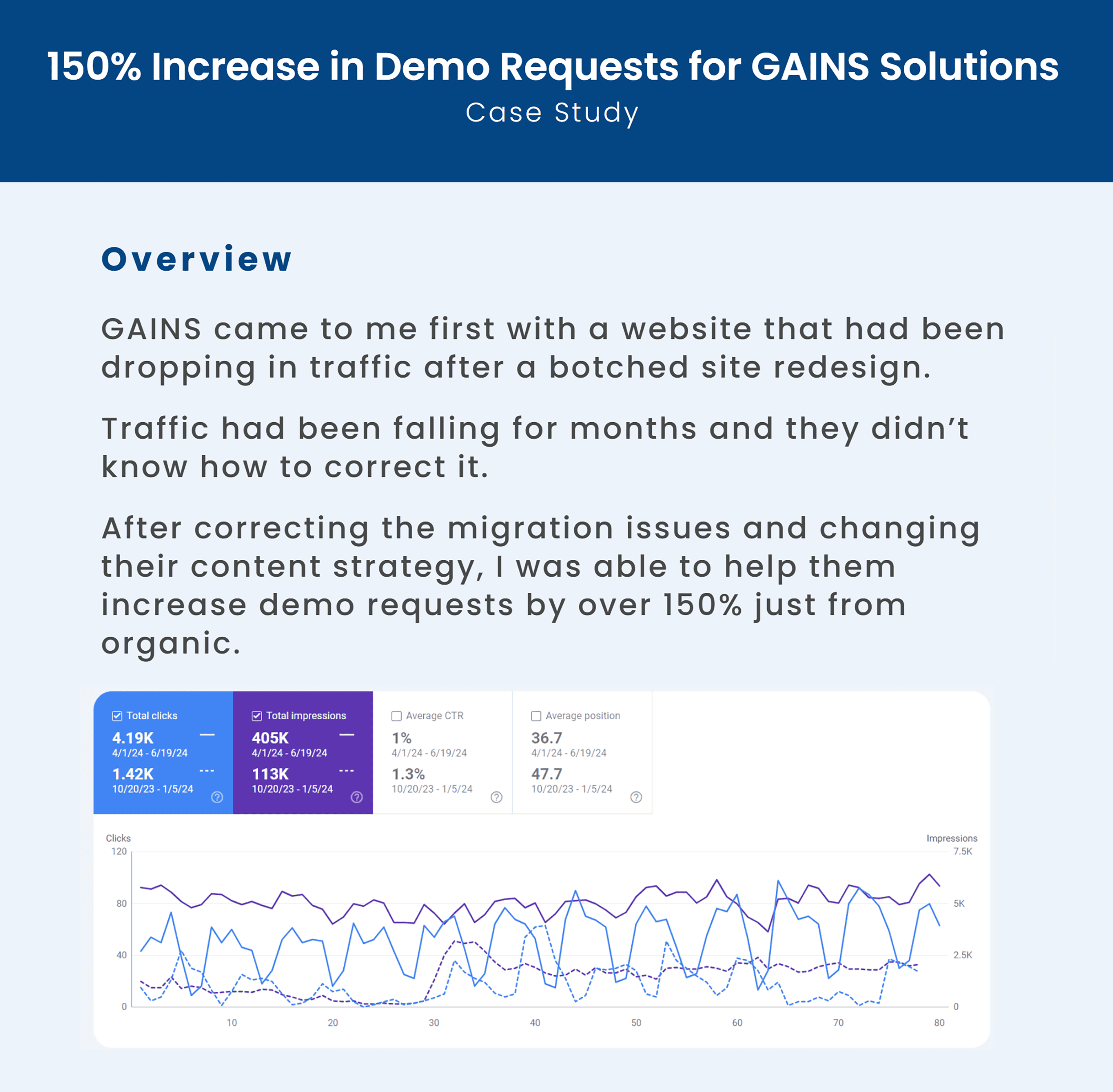
It’s especially helpful if you have a case study that addresses each client’s specific needs.
Kevin Indig, a growth advisor who has worked with companies like Nextdoor, Dropbox, Hims, and Reddit, believes there’s nothing more powerful than demonstrating real results.
Build out references and projects you can showcase. Very early on, it’s important to be able to show what the work for a client could look like at the hand of a live example.
If you’ve done it for someone else, you can do it for them, too.
Another perk?
Case studies are versatile.
Present them during client calls to get buy-in.
And highlight them on your site for prospects to read.
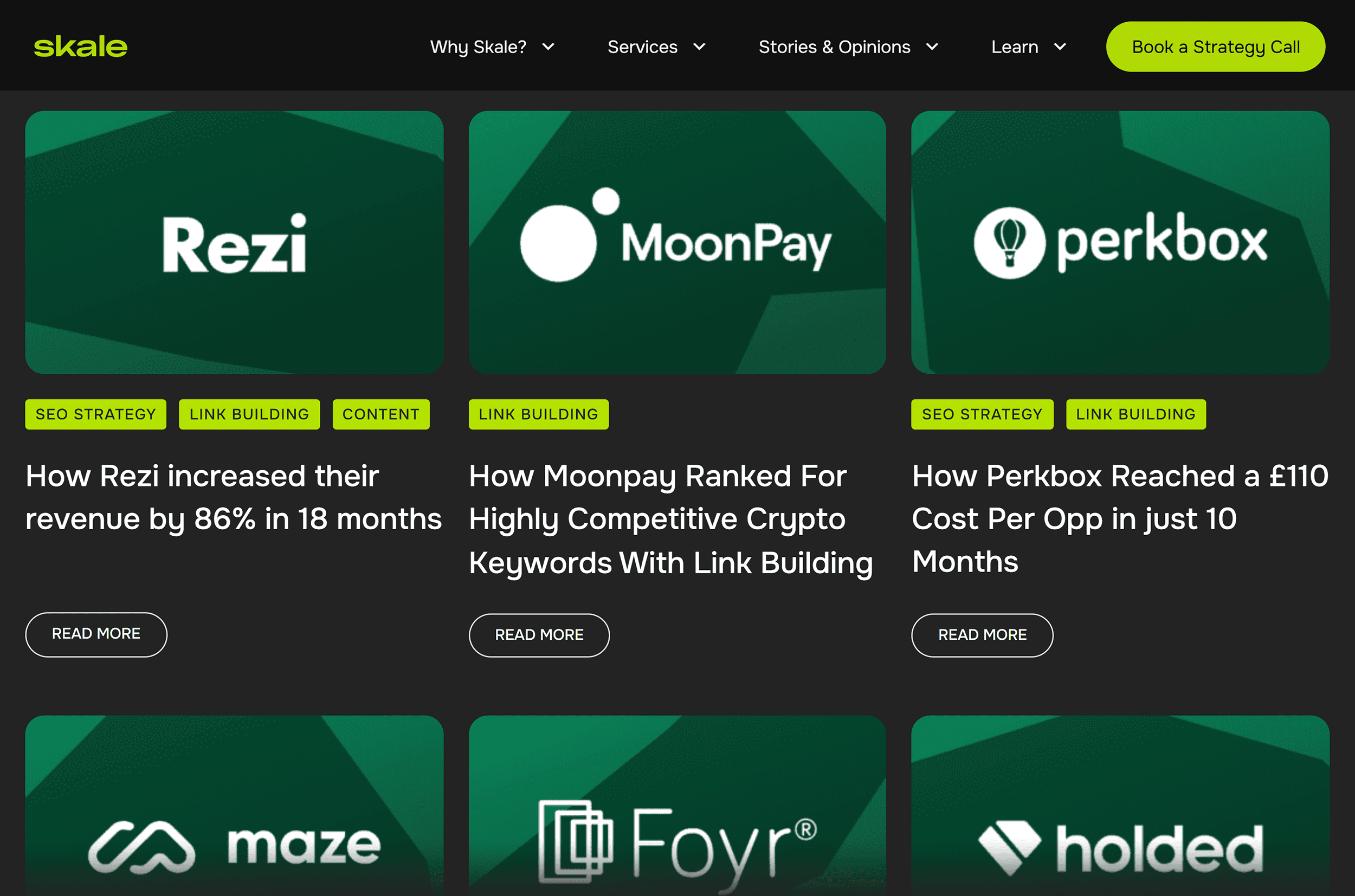
Pro tip: New to SEO? Exchange free or discounted SEO work for case studies and testimonials. For example, offer a free technical audit to a small business. Once they start seeing results, ask if you can document their success story.
Collect High-Impact Testimonials
Case studies are great.
But testimonials hit differently.
Why?
Because they come directly from your happy clients.
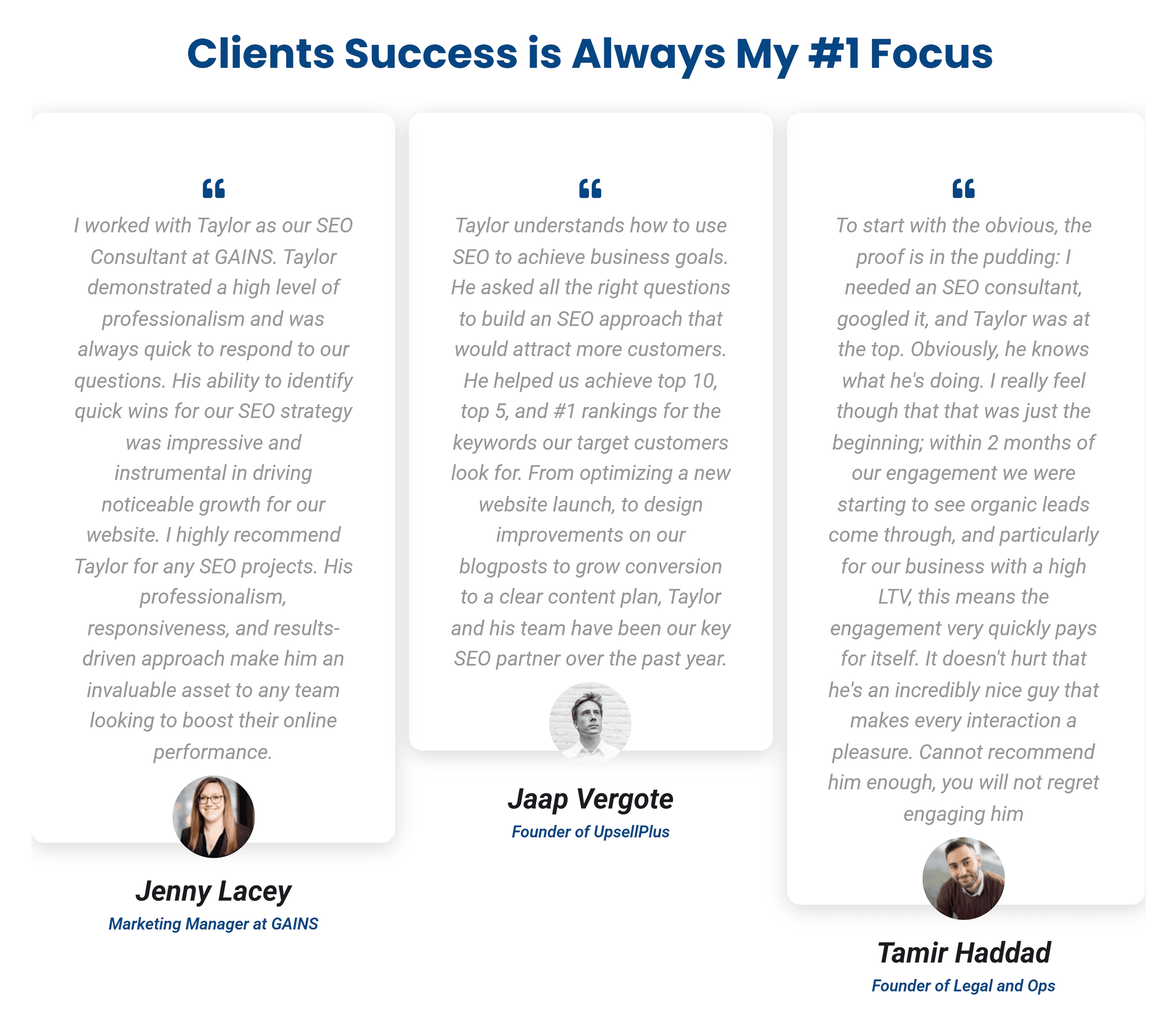
When clients explain the impact you’ve had on their business, it boosts your credibility with prospects.
So, let them be your ambassadors.
Follow these steps to collect testimonials:
- Text or email clients a short feedback form
- Ask them to share specific results (metrics help)
- Keep it simple: “What was your biggest win from working with us?”
- Offer to draft it for them (just get their approval)
Even better: Ask for a video testimonial.
If clients are willing to have their face and brand associated with your business, that’s a ringing endorsement.
It doesn’t get much better than that.
No matter how you collect the testimonial, what matters most is that it comes from a reputable person in the company.
Aim for a VP of marketing or founder for the most significant impact.
Pro tip: Place your best testimonials on high-traffic pages, such as pricing, services, and contact pages. Highlight them in post-discovery call emails and on social media to seal the deal.
Create a Lead Qualification System
Time is money.
Don’t waste it on unqualified leads.
Before you even have a first call with your prospects, ensure they fit your ideal client profile (ICP).
Make sure they:
- Are the right type of company you want to work with
- Are actually in need of your services
- Aren’t looking to just sell you on something (it happens more often than you think)
Pro tip: Asking for project details is usually the best way to qualify a lead. It also helps you set expectations for your role and prepare for the initial discovery call. This way, you come to the meeting with a personalized approach that reflects what they actually need and explains how you can help.
So, how do you have a qualifying process before a prospect even reaches out to you?
Your contact form is your best friend here.
Add qualifying questions that will tell you from the get-go if this lead has potential.
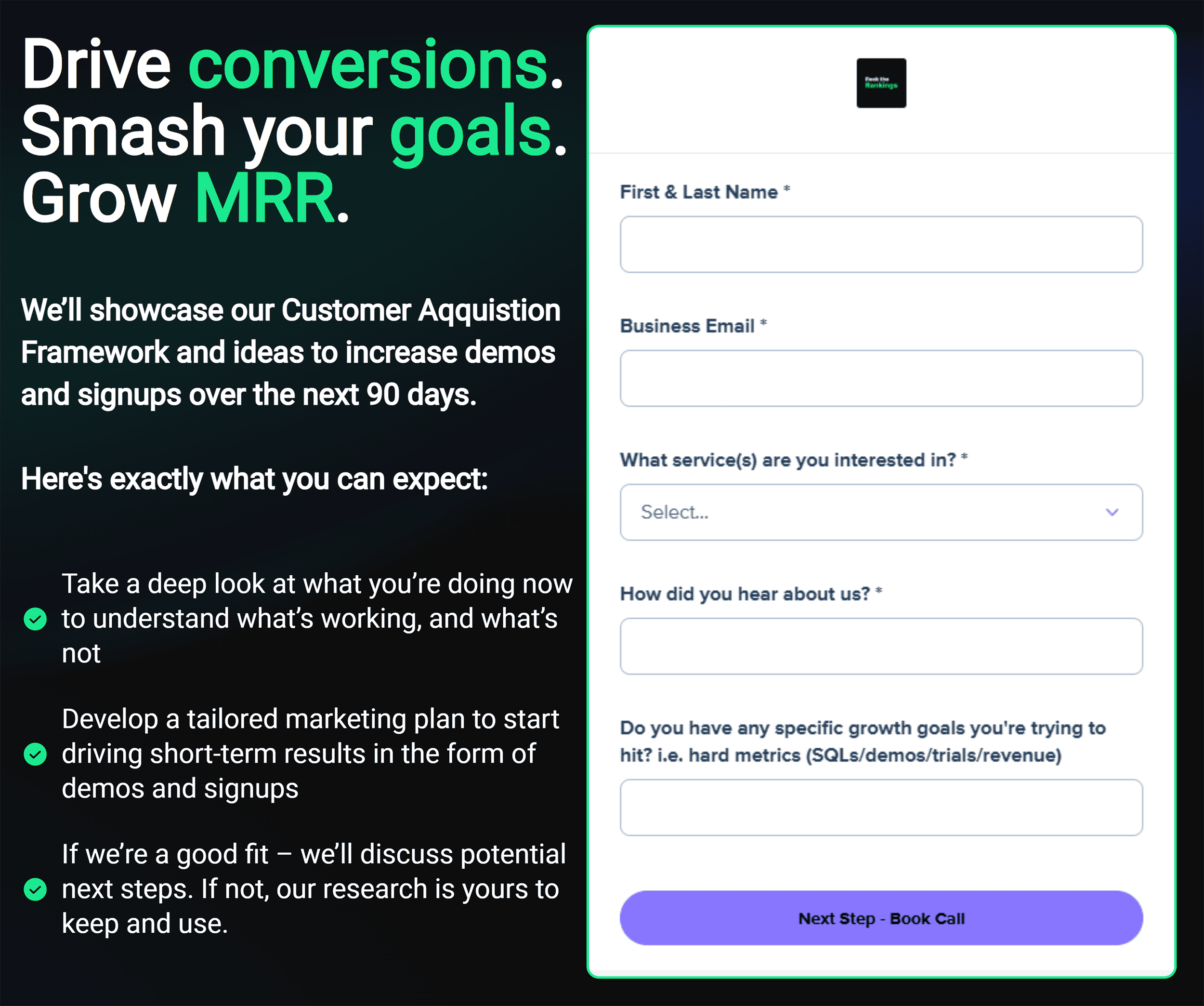
Here’s what your contact form should ask:
- Budget range
- Services they need
- Project details
- How they found you
In my experience, the responses will tell you whether they’re a legitimate lead 95% of the time.
Further reading: What Are Lead Magnets?
Invest in a CRM
I won’t lie—not having customer relationship management (CRM) software was probably the worst mistake I’ve made as a consultant.
It took me around six months to finally realize this.
That’s six months of lost revenue, wasted time, and unnecessary stress.
If I ever had more than five leads contact me at once, it was just pure chaos managing them with a spreadsheet.
If you’re a solo SEO consultant or freelancer, I can’t recommend using a CRM enough.
You’ll be able to:
- Manage and track your prospects
- See which leads are hot, warm, or cold
- See how long it’s been since a lead contacted you
- Qualify that lead by seeing which company they’re from
I would personally recommend HubSpot as the best all-in-one CRM–especially if you’re a new SEO.
It can manage all your sales data and give you access to a full range of marketing tools.
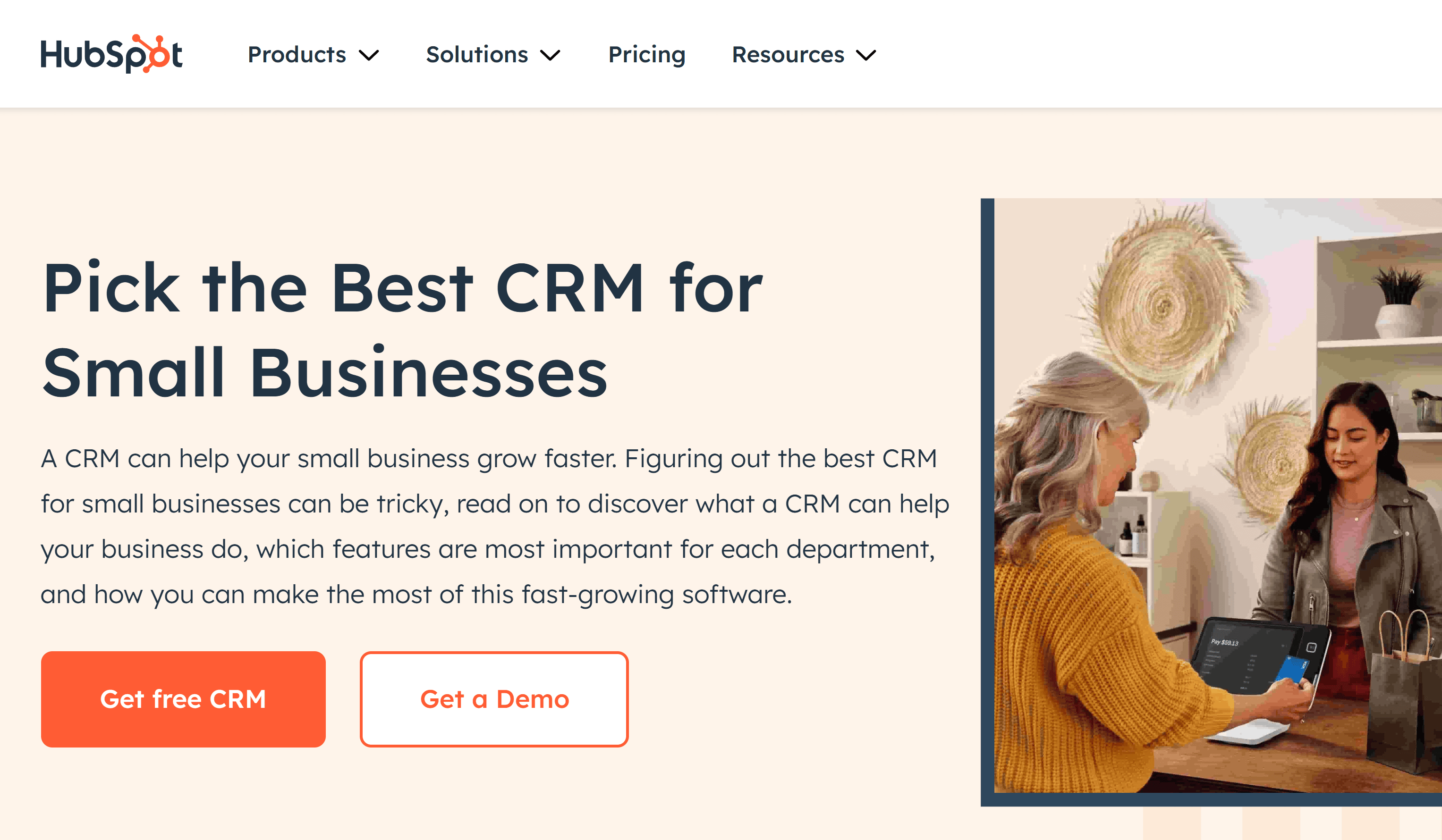
But a few other CRMs worth looking into would be:
- Semrush
- Apollo.io
- Salesforce
- ClickUp
Decide on Your SEO Services
Want to know why many SEOs struggle to close deals?
They’re not specific enough about the SEO services they offer.
Here’s what I mean:
Don’t just say you “do SEO.”
Instead, decide what services you’ll offer and be specific when you describe them:
- Technical SEO for enterprise companies
- Content creation for B2B SaaS
- Link building for ecommerce sites
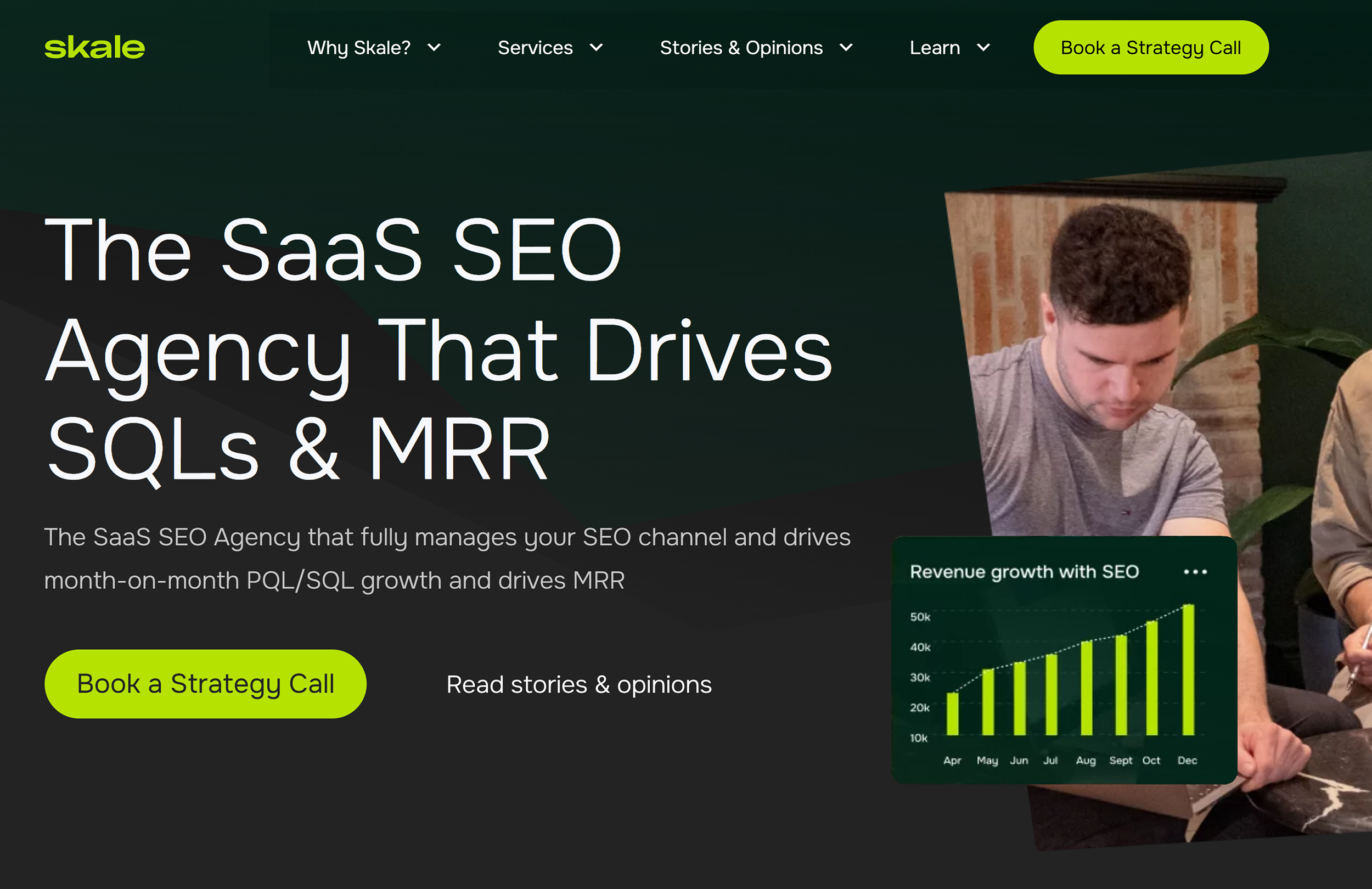
Niche down whenever possible.
Once you control a niche, whether B2B SaaS, home care, or legal SEO, it will be much easier to grow from there.
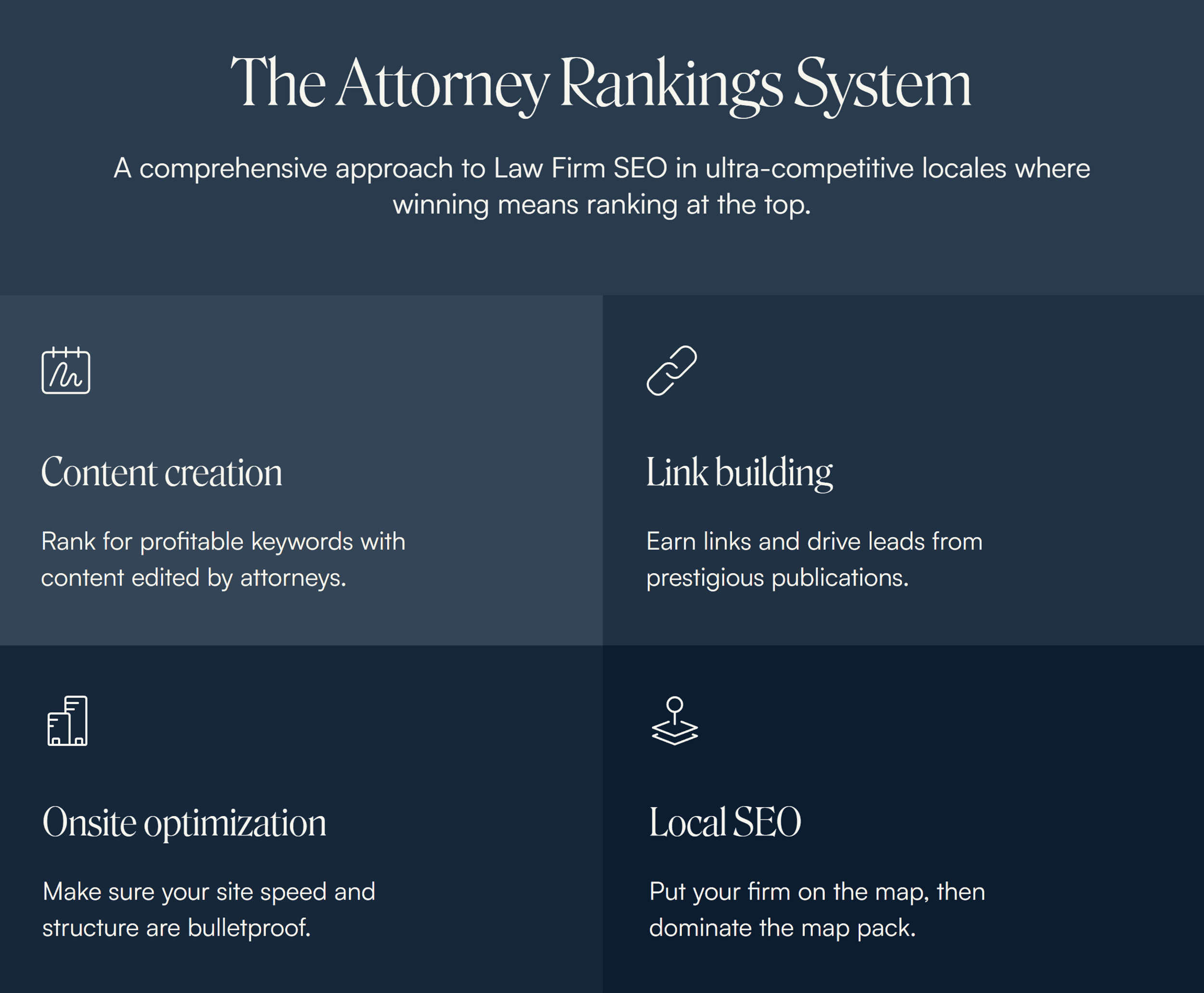
I learned that the hard way when I first started posting on LinkedIn.
My niche and SEO posts were too broad.
The posts helped grow my followers quickly but not my revenue.
The majority of my followers were SEOs, not my actual ideal client profile.
So, I wasn’t generating leads.
That changed pretty quickly after I nailed down my niche.
After focusing my posts on B2B SaaS to help target my ICP—marketing VPs—I saw better results.
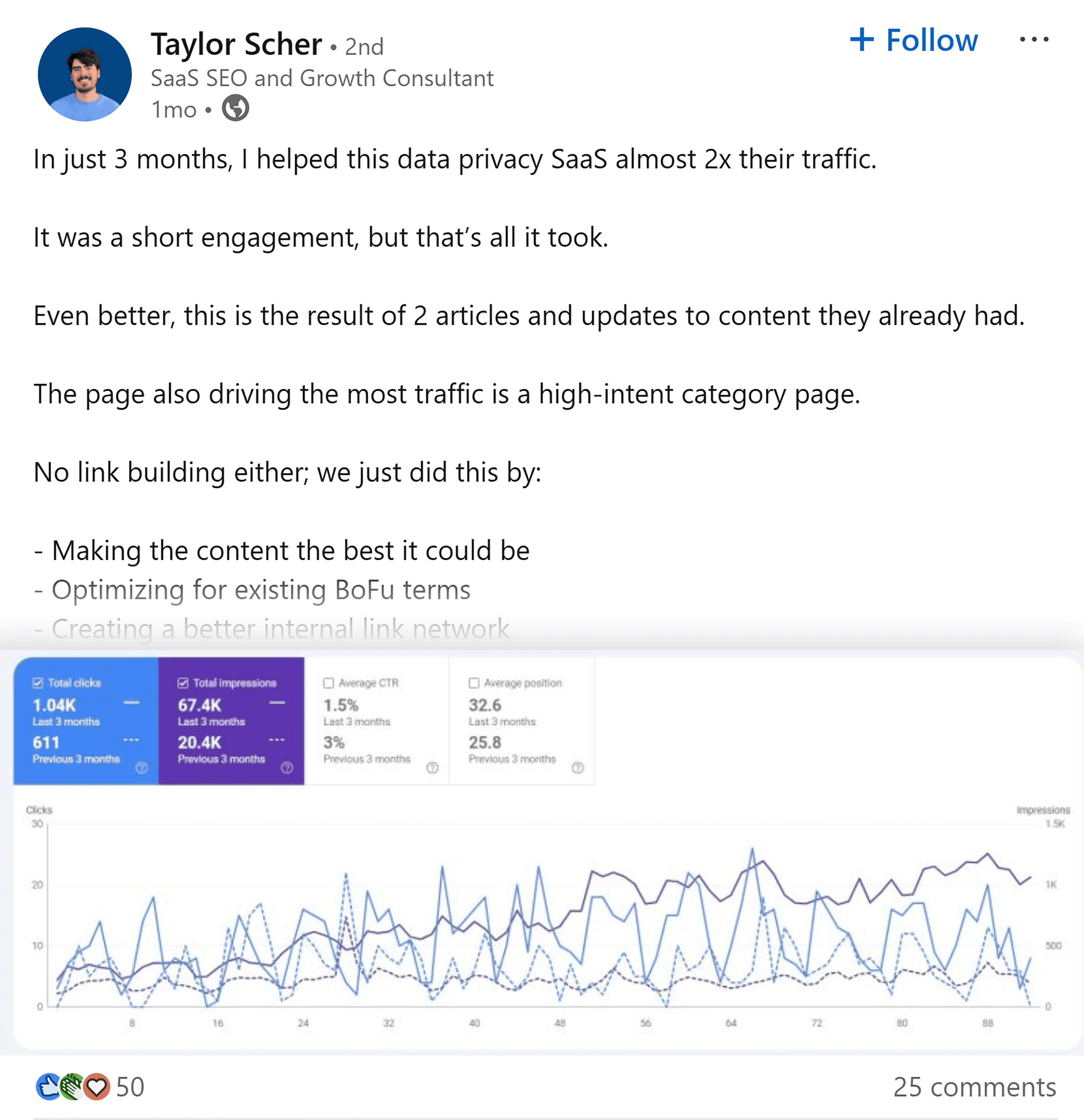
Instead of competing with every SEO agency out there, I have an easier time being seen by my ICP.
Plus, they know my services are designed specifically for them.
Another important decision will be how you want to structure your services.
Kevin recommends creating a clear distinction between freelancer and consultant work.
You need to know very clearly whether you want to do the work (freelancer) or guide/advise (advisor). Early on, I did a lot of the leg work because that’s where I felt most comfortable, but that didn’t match the advisor prices I charged and wasn’t what I actually wanted to do.
So, it’s important to know what work you want to do and where you can provide the biggest impact. If you want to advise, don’t agree to do any busy work. Focus on the strategy.
You’ll likely have to learn your preferences by trial and error at first.
But don’t be afraid to adjust if you have to.
Choose Your Pricing Model
Like your services, you’ll want to have your pricing figured out upfront, too.
This works well for a few reasons:
- You understand your worth before going into a client call
- You can use it to qualify leads before they reach out
- You avoid being lowballed during calls
Let me break down the four main ways to price SEO services:
First, there’s retainer pricing.
Clients pay a fixed monthly fee for ongoing SEO work. You commit to a set number of hours each month.
Next, there’s package pricing.
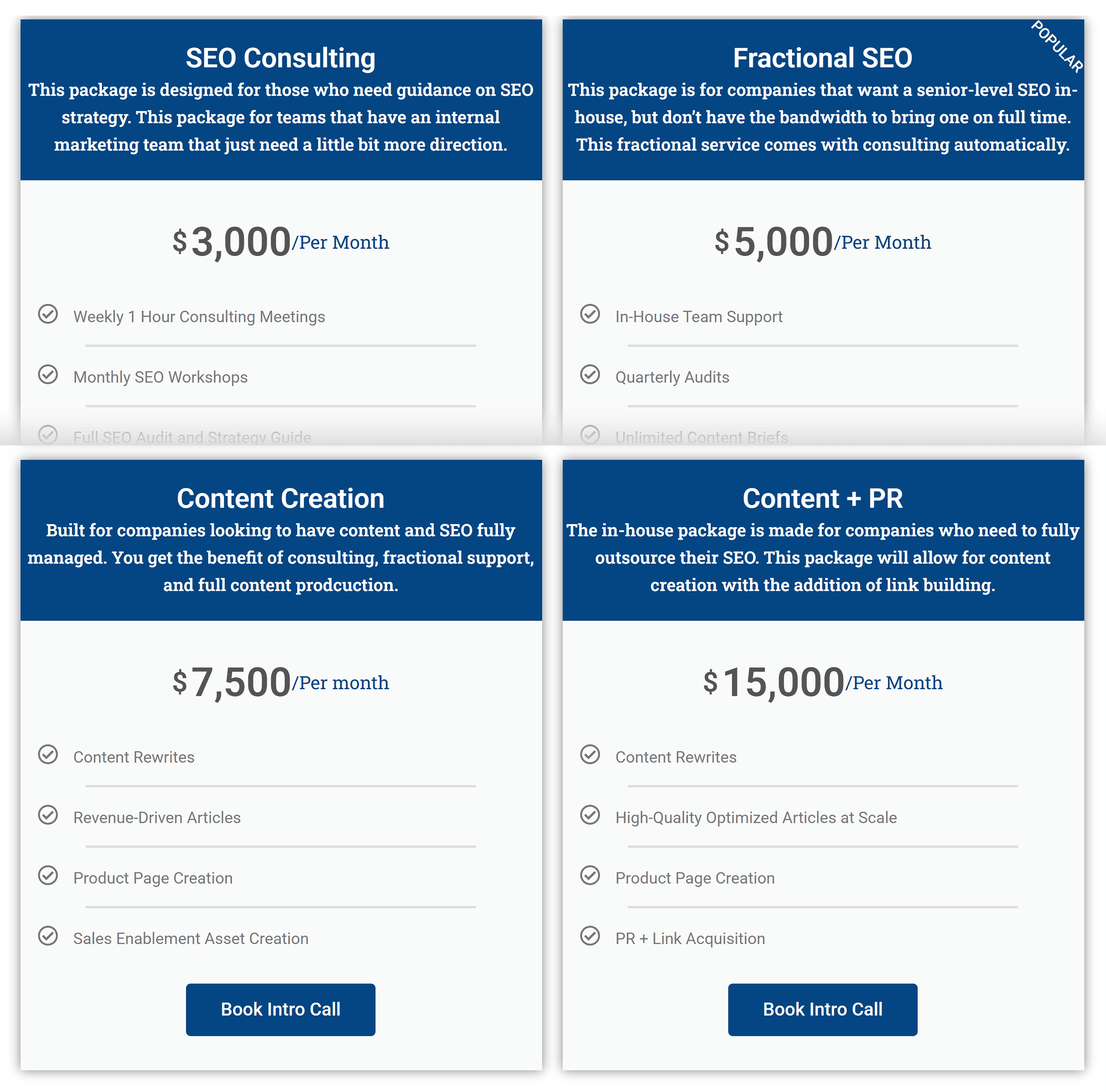
This is what I use. Clients can choose from different packages that best suit their needs for SEO.
Here’s how I structure it:
- SEO audit: $1,500
- SEO consulting: $2,000
- Fractional SEO: $3,500
- Full management SEO: $6,000
Your third option is value-based pricing.
It’s riskier but can pay off big. You set goal targets with clients and get bonus compensation when you hit them.
Finally, there’s hourly pricing.
You bill based on actual time spent on SEO tasks. This is great for one-off projects.
Pro tip: Price your services based on value. Low rates might seem like a path to more clients, but they can attract lower-quality clients. My highest-paying clients are always my best clients—they pay on time, are pleasant to work with, and trust my expertise.
Keep in mind that every model is dependent on what works for you.
I’m personally a big fan of package pricing.
But that’s because I want my work to prioritize value over output.
Optional: Gather Proof You Can Rank
Want to know one of my best-selling tools?
My own SEO results.
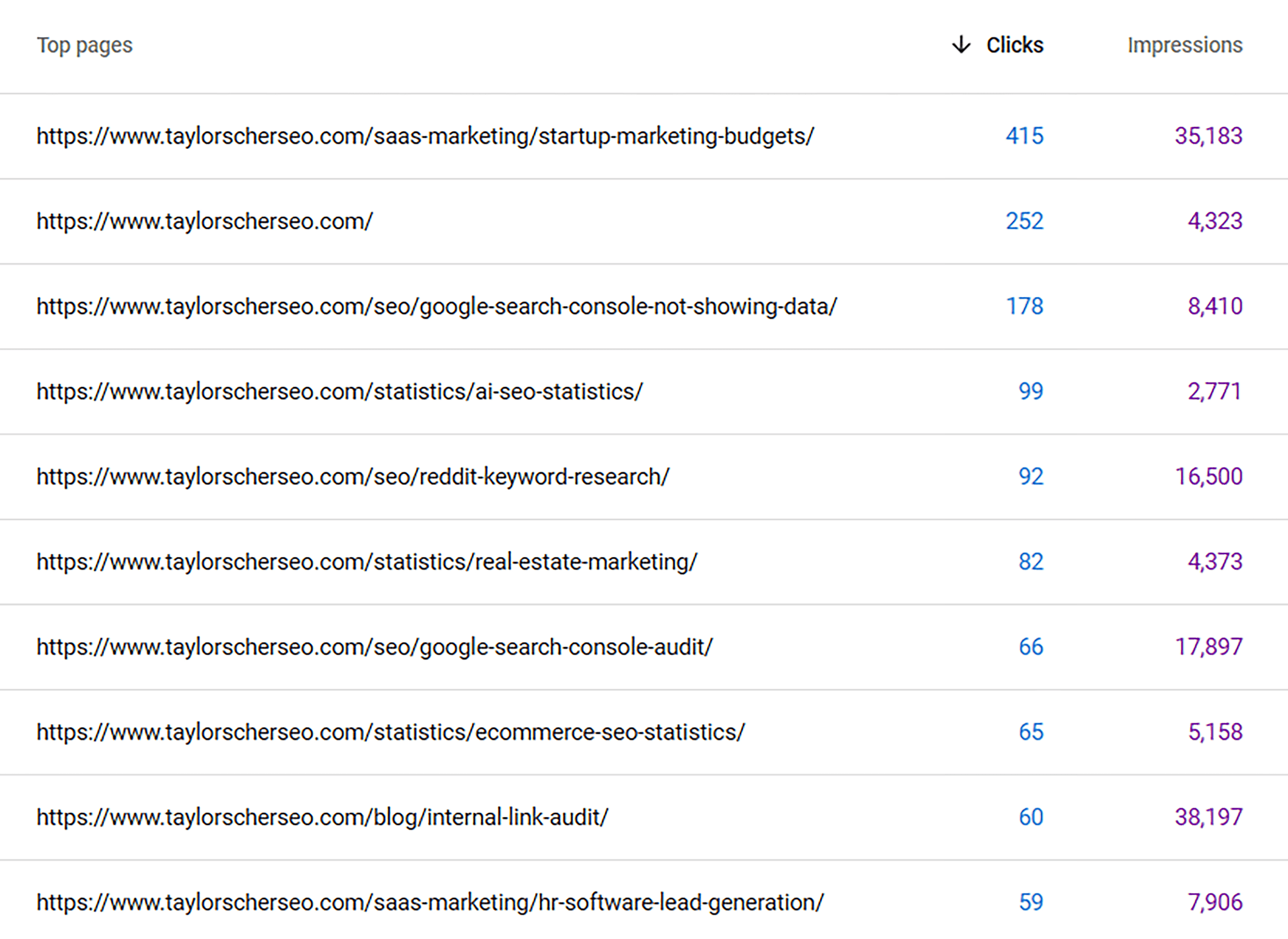
Think about it:
What better way to prove your SEO skills than having prospects find your website through Google?
It’s an instant trust signal.
In fact, organic search is one of my most consistent channels for new leads.
But here’s the catch:
Don’t just rank for random topics.
Rank for topics related to your services:
- Best SEO agencies for lawyers
- Technical SEO for Shopify websites
- B2B SaaS SEO consultant
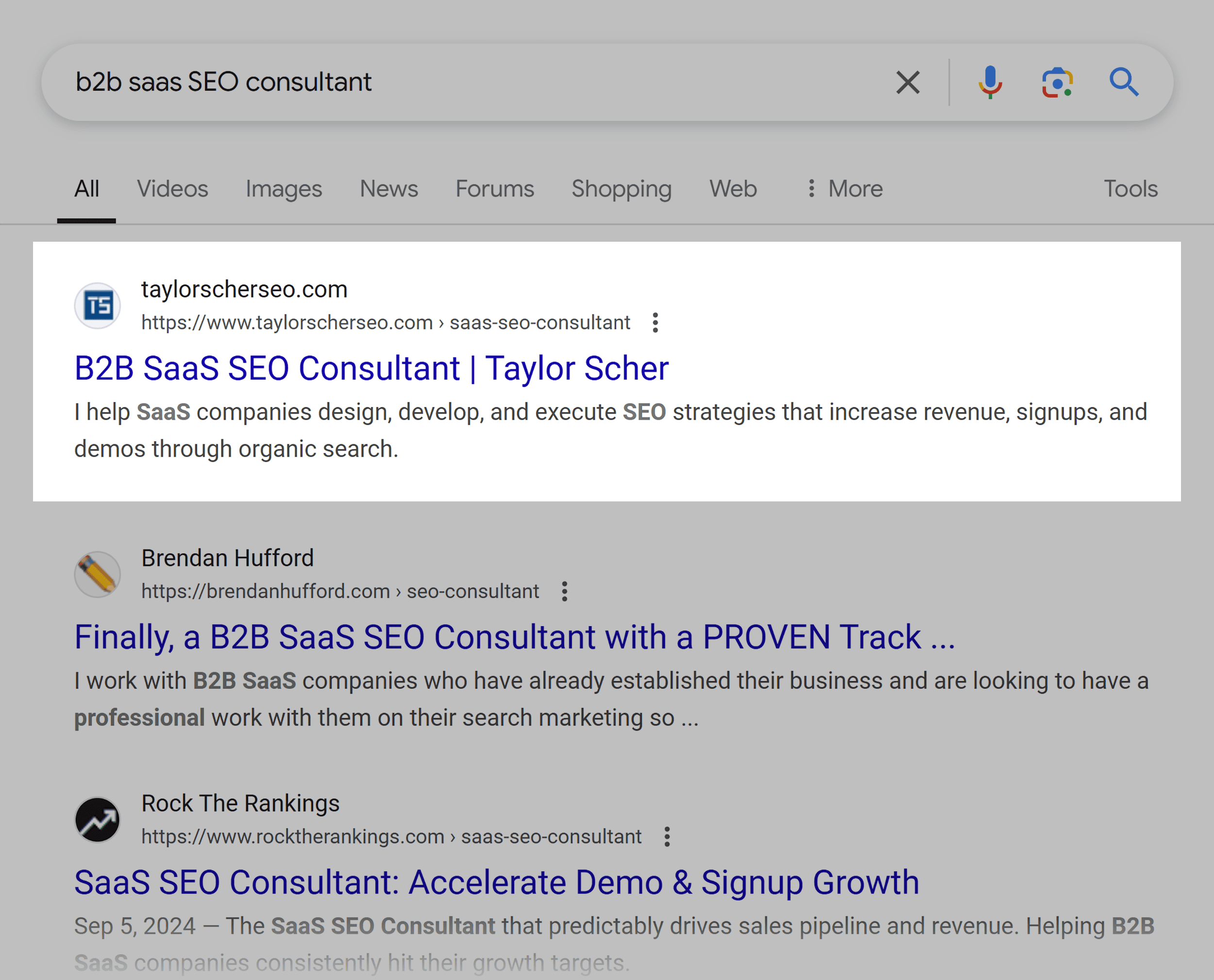
There’s no denying that building SEO authority from scratch is tough.
I learned this firsthand when launching my site.
Competing against established SEO websites with zero website authority? Not easy.
Here’s my best advice: Run PPC campaigns while your SEO compounds.

This keeps your lead pipeline full while you build organic visibility.
Further reading: SEO vs. SEM: What’s the Difference?
2. Find Prospects
Successful SEO sales require a reliable lead-generation system.
Here’s how I use both inbound and outbound marketing to build a steady stream of qualified prospects.
Inbound Prospects
Inbound marketing is the process of creating valuable content that attracts potential customers to your site when they’re actively looking for solutions.
This is the channel I’m most familiar with.
And the one that provides the most long-term value.
With inbound, you can build a long-term community that’s invested in your brand and create a stronger pipeline for leads at a much lower acquisition cost.
So, how do you find high-quality leads? It depends on your services and industry.
Personally, I’ve found the most success with:
- SEO: Targeting high-intent searches coming directly from my audience
- Reddit: Answering questions on subreddits where my ICP is
- YouTube: Creating videos that help my audience overcome industry challenges. Works great for repurposing content, too.
- Email marketing: Nurturing my email audience by sending them highly valuable content directly to their inbox
- LinkedIn: Posting thought leadership content that establishes me as an expert within my field
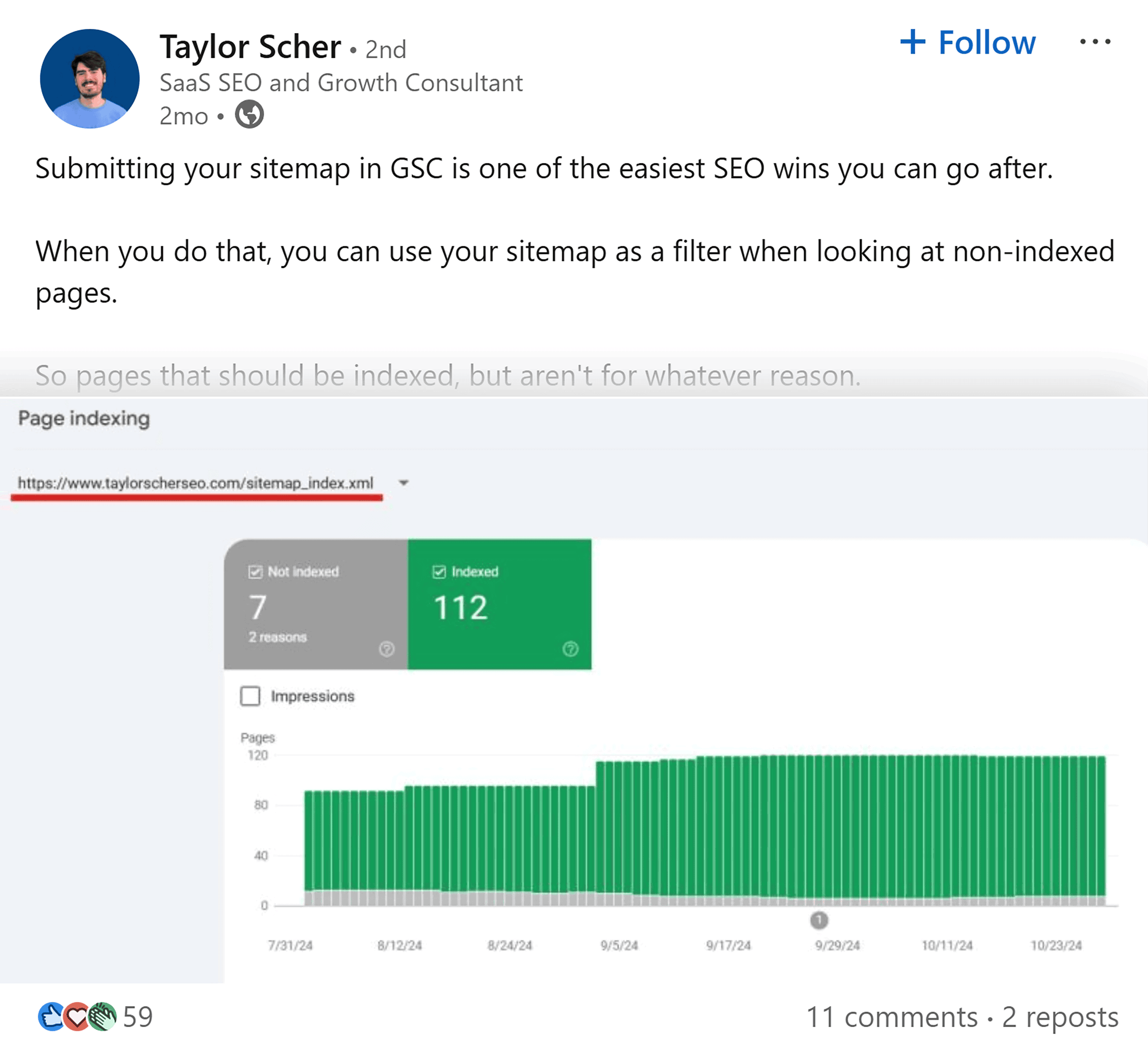
As you can see, organic search and social are among my top traffic sources:
[missing ss]
When you’re starting out, I recommend playing around with each channel.
Once you find the channel that works, double down on it.
Pro tip: Don’t stretch yourself too thin. If you’re solo, it’s better to comfortably handle one or two channels than struggle with five. The goal is to build a community interested in your brand through quality content—not spam your audience.
Outbound Prospects
Outbound marketing is when you reach out to prospects through various methods rather than waiting for them to find you.
While I’m pro inbound marketing, it can be inconsistent.
Outbound can make up for that.
There are a few different ways you can target outbound prospects.
But the ones that work the best for me are:
- Cold outreach
- Social ads
- PPC
For example, I use a template similar to this to reach out to potential prospects through email:
Hi [Name],I noticed [company name]‘s content showing up for [specific keyword] but ranking on page 2. Looking at your competitors [(Competitor 1)] and [(Competitor 2)], there’s a clear opportunity to capture more organic traffic with some technical improvements.
I’ve helped other [industry] companies like [reference company] improve their search visibility and recently published a case study breaking down the exact process we used to increase their organic traffic by [X]%.
Would you be interested in seeing the case study? It includes specific tactics you could implement, whether you work with us or not.
Either way, I’ve also spotted a few quick SEO wins for your site that I’m happy to share.
Best,
[Your name]
You can also use LinkedIn for outreach, but don’t expect to take the same approach as email.
Focus on social selling.
Interact with your ICP and find something in common with them.
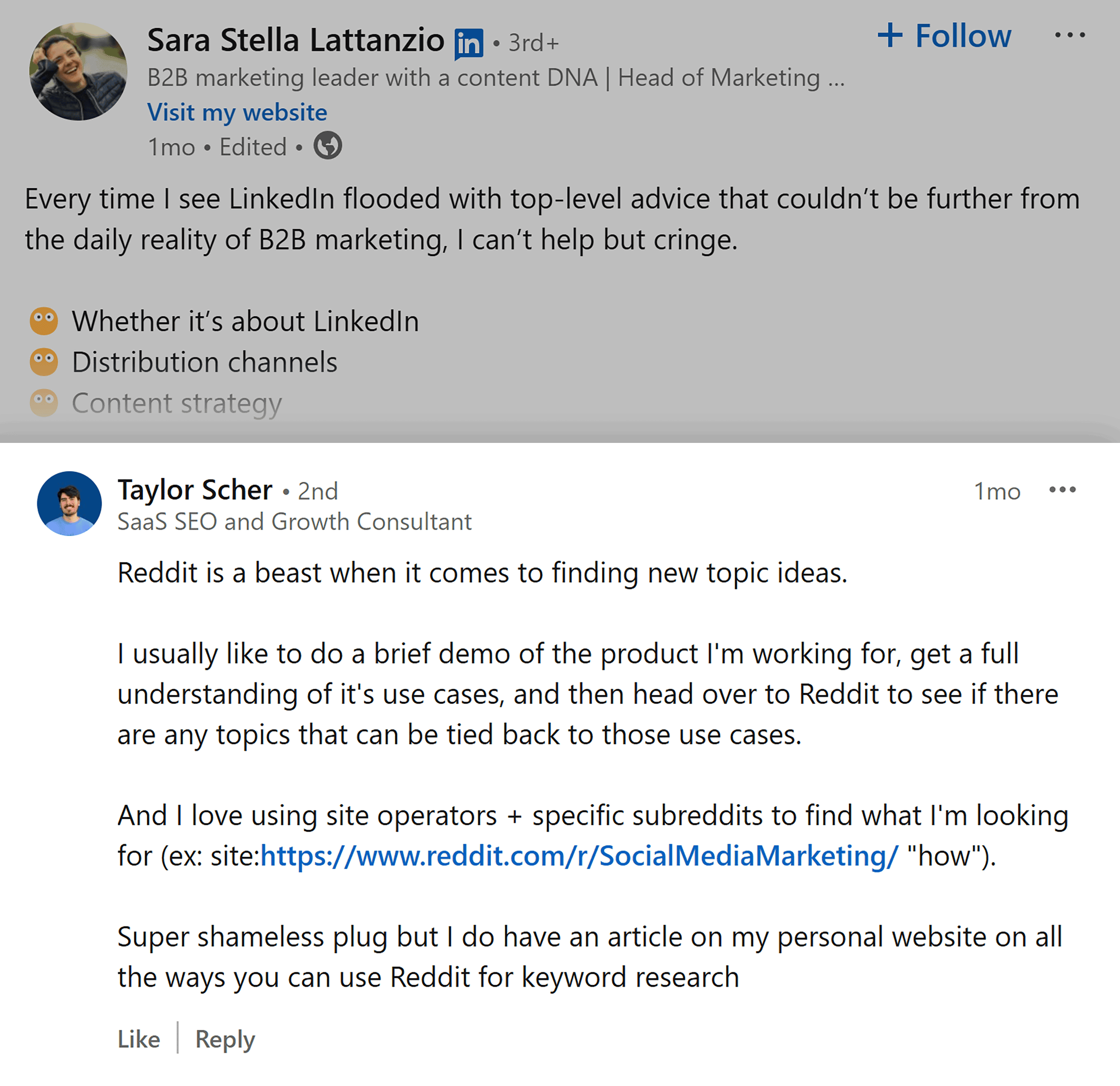
Then, reach out to them.
Don’t treat them as just another automated message.
Focus on building an actual relationship with them.
Then, once the time is right, see if they’d be open to a coffee chat.
Ask if they’re facing any challenges with SEO and offer advice on how to help.
Chances are, they might just be willing to delegate that to you, anyway.
But when you’re deciding which marketing channels to use, I recommend this approach:
Pro tip: Blend one outbound channel with one inbound. Outbound brings quick wins, while inbound builds long-term success. Together, they offer a balance of quick wins and sustainable growth for long-term success.
3. Offer Strategy Calls
This step is often called a “discovery call.”
But I recommend using strategy call instead.
Why?
Well, you want to demonstrate perceived value before prospects even contact you—an additional incentive for them to take that next step.
And “strategy” implies they’ll get something tangible out of this call.
For example, point out issues they can fix right after the call. It’s an easy way to show you’re invested in them and have done your research.
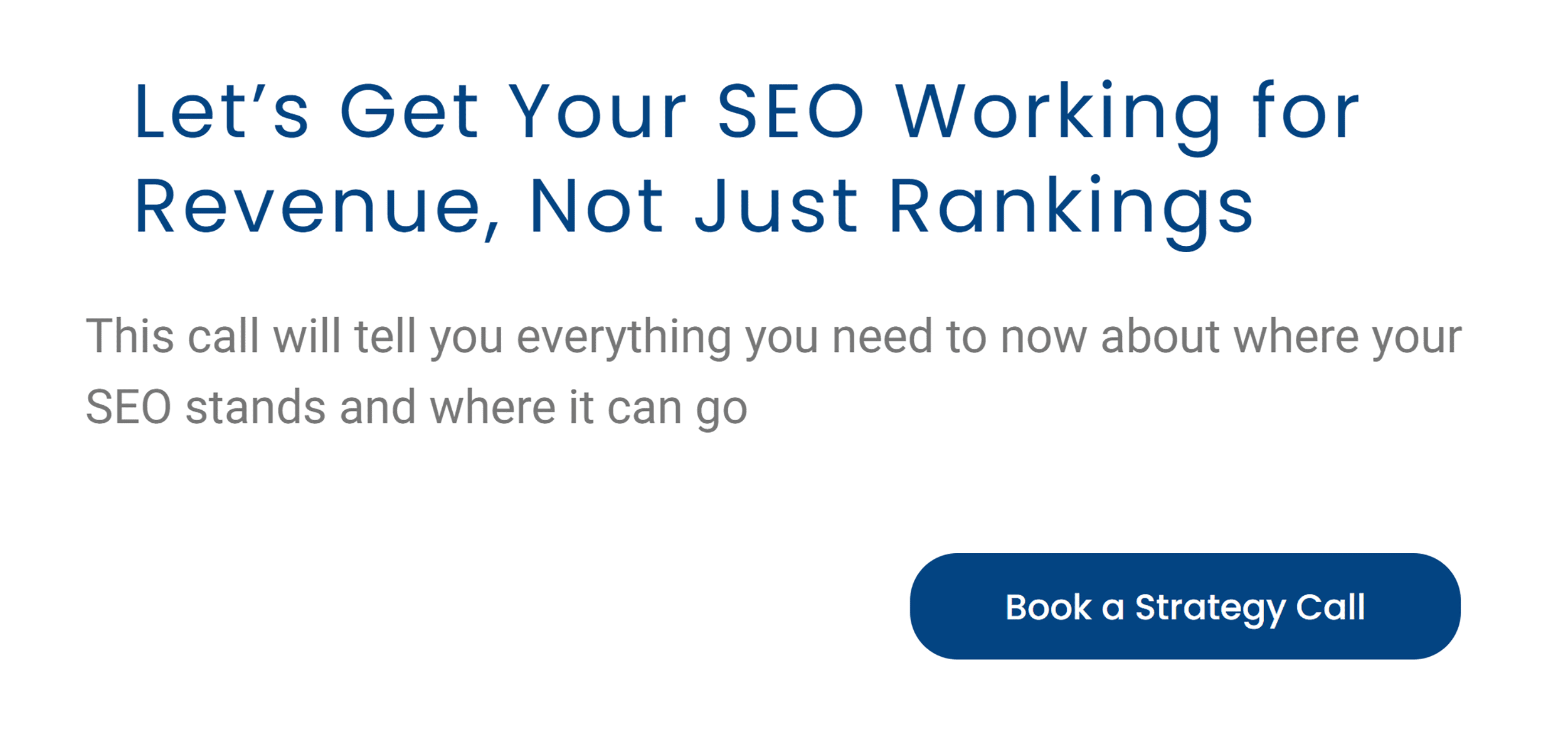
Use this call to discuss your services and offer a glimpse into what working with you looks like to see the best conversion rates.
Learn More About Your Prospect
Use the first call strictly as a way to understand the company and what’s currently going on with its marketing efforts.
I even recommend using a questionnaire to help you run through the call.
Here’s what I ask every prospect:
- What do you hope to achieve with this call?
- What are your long-term SEO goals?
- What’s your current SEO strategy?
- What makes your product unique?
- Who are your decision-makers?
- How does your sales process work?
- What sets you apart from competitors?
I usually ask these questions to help prepare myself for the SEO audit in the next step.
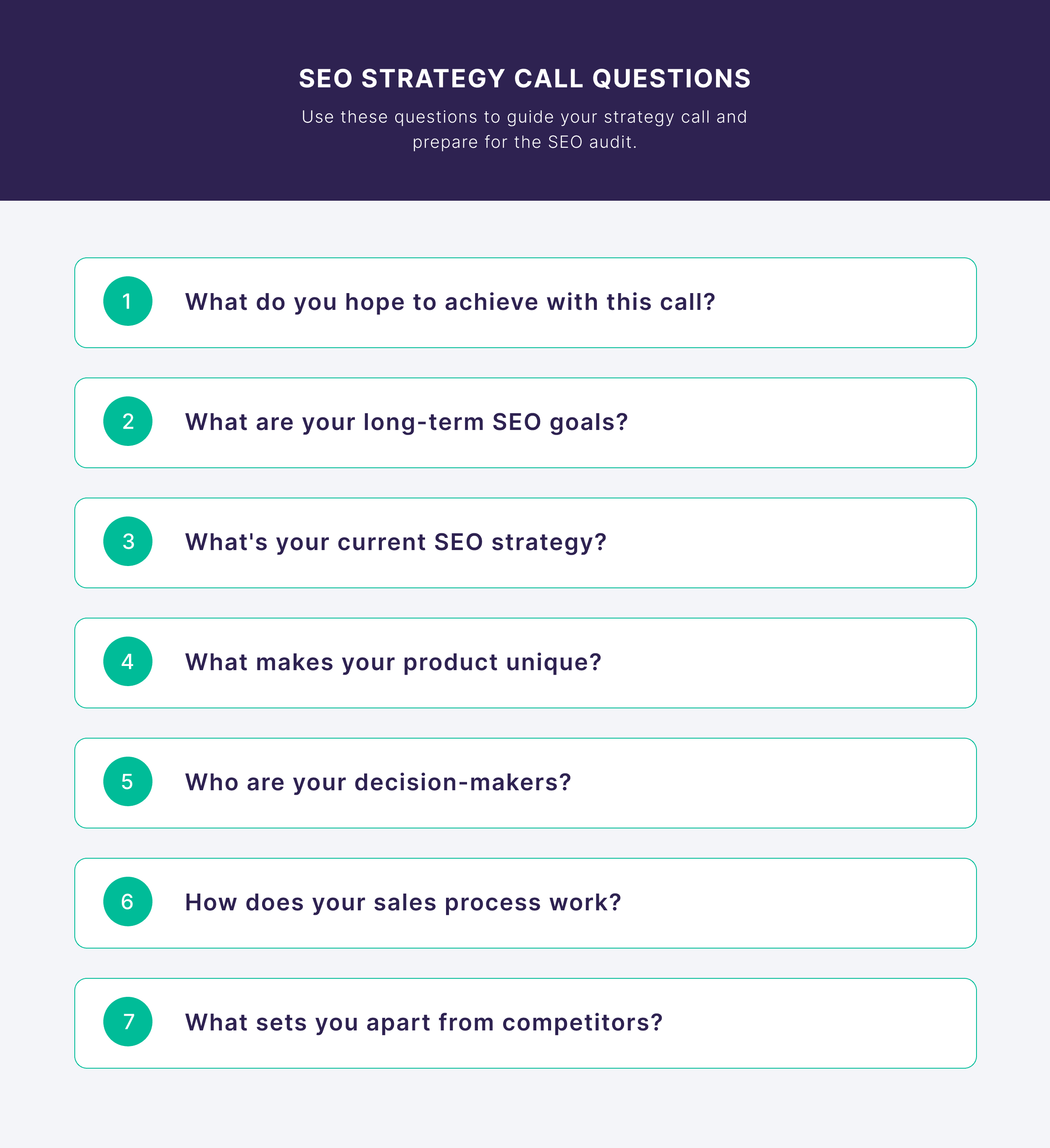
But prospects also appreciate that you seem invested in their company.
You’re obviously not just pitching yourself and are actively looking to learn more about them—something that’s often rare during the discovery phase.
Focus on Early Wins
Here’s a persuasive tactic: Give prospects actionable tips during the call.
Point out easy fixes they’ve missed to highlight your expertise and prove your worth.
For example:
“I noticed your product pages aren’t targeting money keywords. Here’s a quick fix that could boost your traffic…”
Or
“I researched some easy keywords you’d be able to rank for quickly. This includes…”
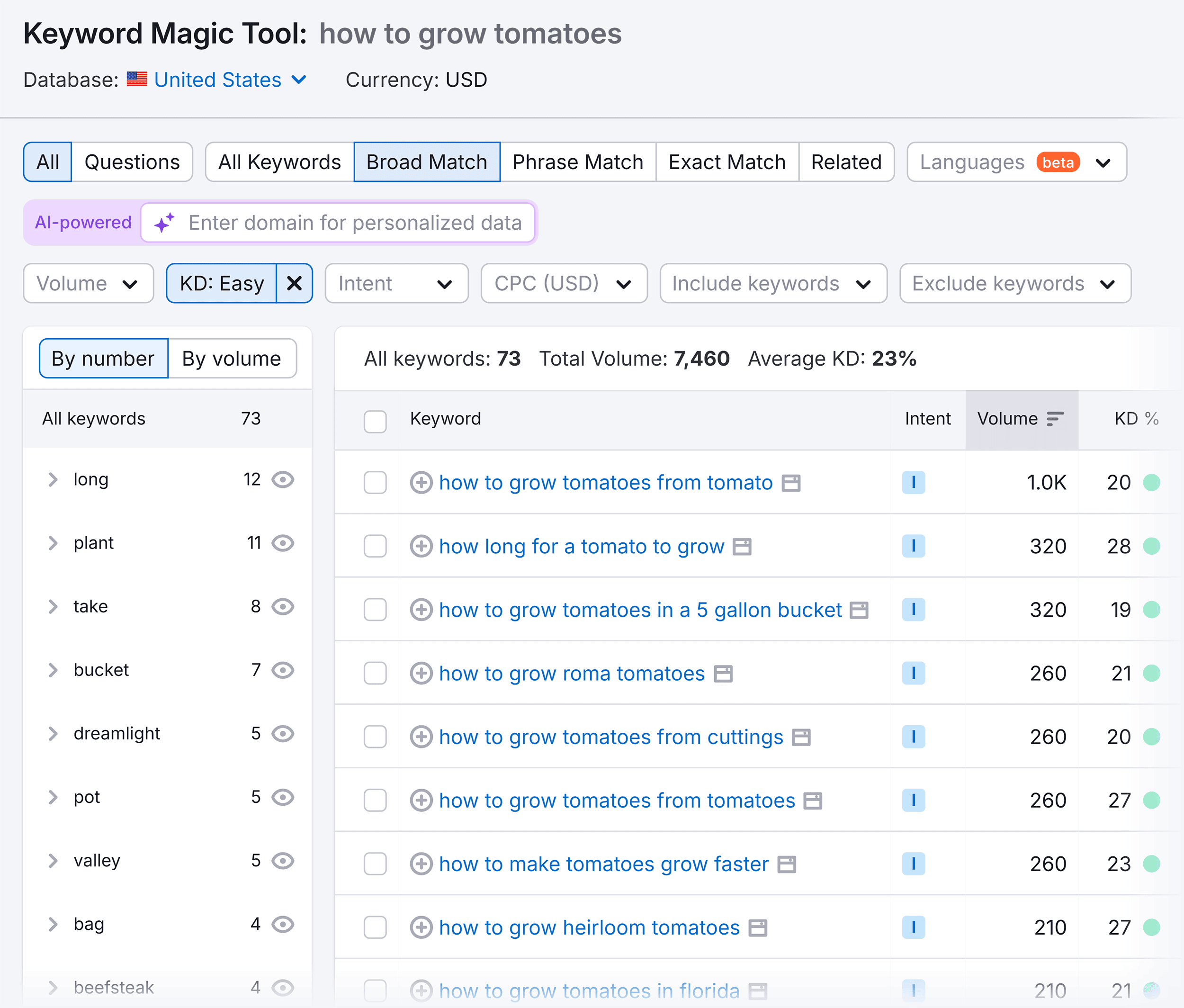
This gives prospects a reason to develop early trust with you.
This is something my friend Jacob Statler, founder of Stat Digital, highly recommends doing:
Show your prospects how you can get them quick wins that tie back to revenue. If possible, get them a win before working together during the sales process.
SEOs often give away high-level audits that they auto-generated with a tool, but these are usually not very actionable. I like to create mini-action plans of easy-to-implement opportunities. This builds trust and shows competency.
And if that quick win translates to results, all the better for you.
Highlight What Their Competitors Are Doing
This is such an underrated strategy.
If you think I’m joking, try it out for yourself.
I’ve been stumped before getting clients to commit to something.
But the moment I mention a direct competitor doing something they aren’t, they get tunnel vision.
This includes:
- Their competitors’ top traffic channels
- Articles their competitors have that they don’t
- Articles their competitors created against them (this is my go-to if a client is ever opposed to creating alternative or category content)
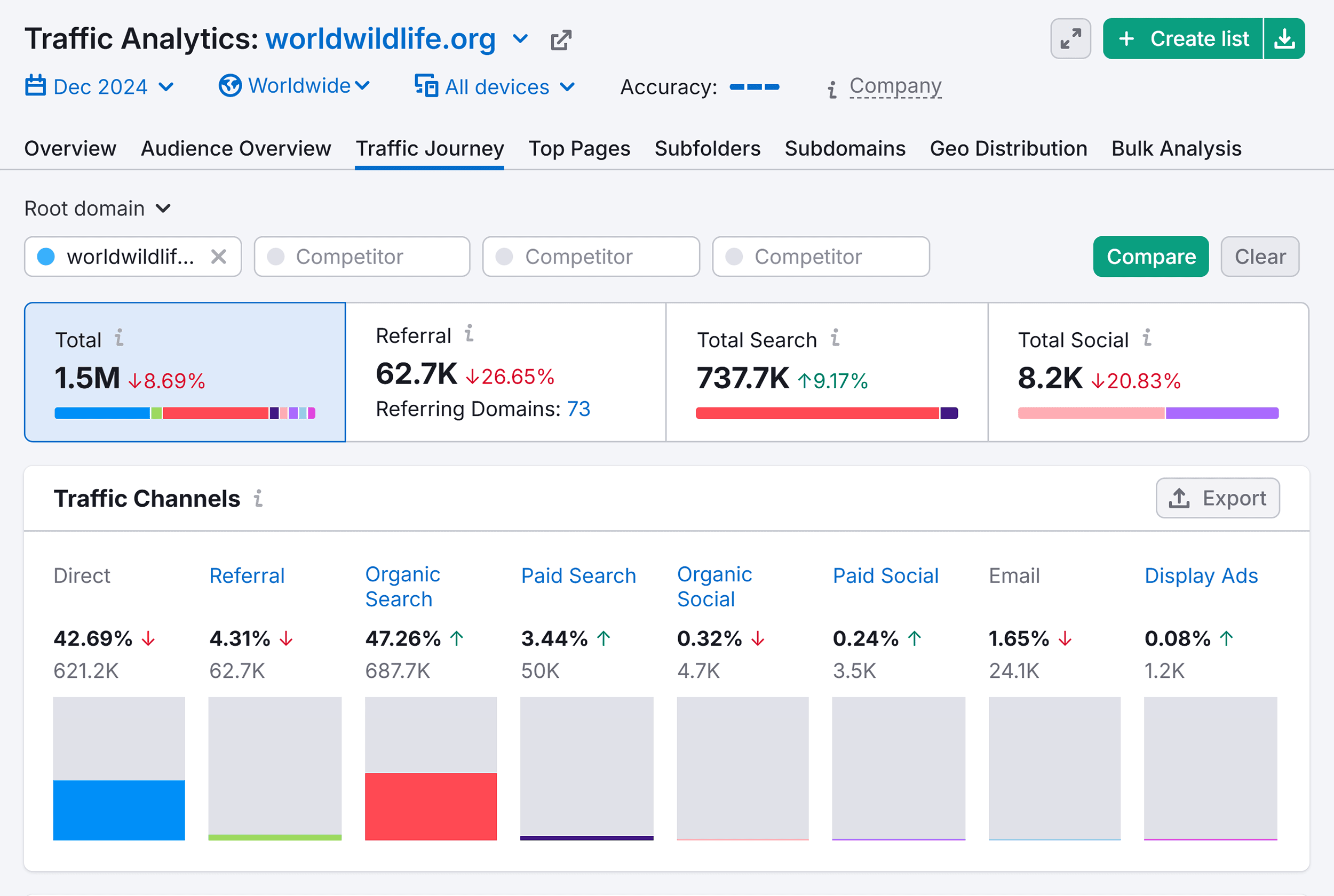
It’s almost an immediate way to motivate your prospects, especially if you’re facing early resistance to a tactic you’re recommending.
You can conduct competitor research in a few ways, but I usually recommend using the following tools:
- Semrush competitor analysis tools
- SpyFu
Pro tip: Offer the SEO audit at the end of your strategy call or follow up with an email to get it scheduled right away.
4. Schedule an SEO Audit
Think about how many agencies and consultants are pitching your prospects right now. Chances are you aren’t the only one being considered.
If you don’t make an impression, you’ll get lost in the crowd.
The solution?
SEO audits.
Pro tip: Always lock in the audit with a hard date. Leaving the audit timeline open is a deal-killer. I schedule the audit presentation right after the discovery call. Vague follow-ups kill momentum.
Position the Audit as a Roadmap, Not a Selling Technique
Audits are my secret sauce for selling SEO services.
Why do they work so well?
I go above and beyond. While others send automated reports, I tailor each audit to my client.
This means I:
- Never use a template; I always start fresh
- Look at their product/offering/industry/ICP to put together my recommendations
- Focus on specific tactics that drive value and have an expected outcome
I’ve found it not only gets additional buy-in but also keeps leads moving through the pipeline.
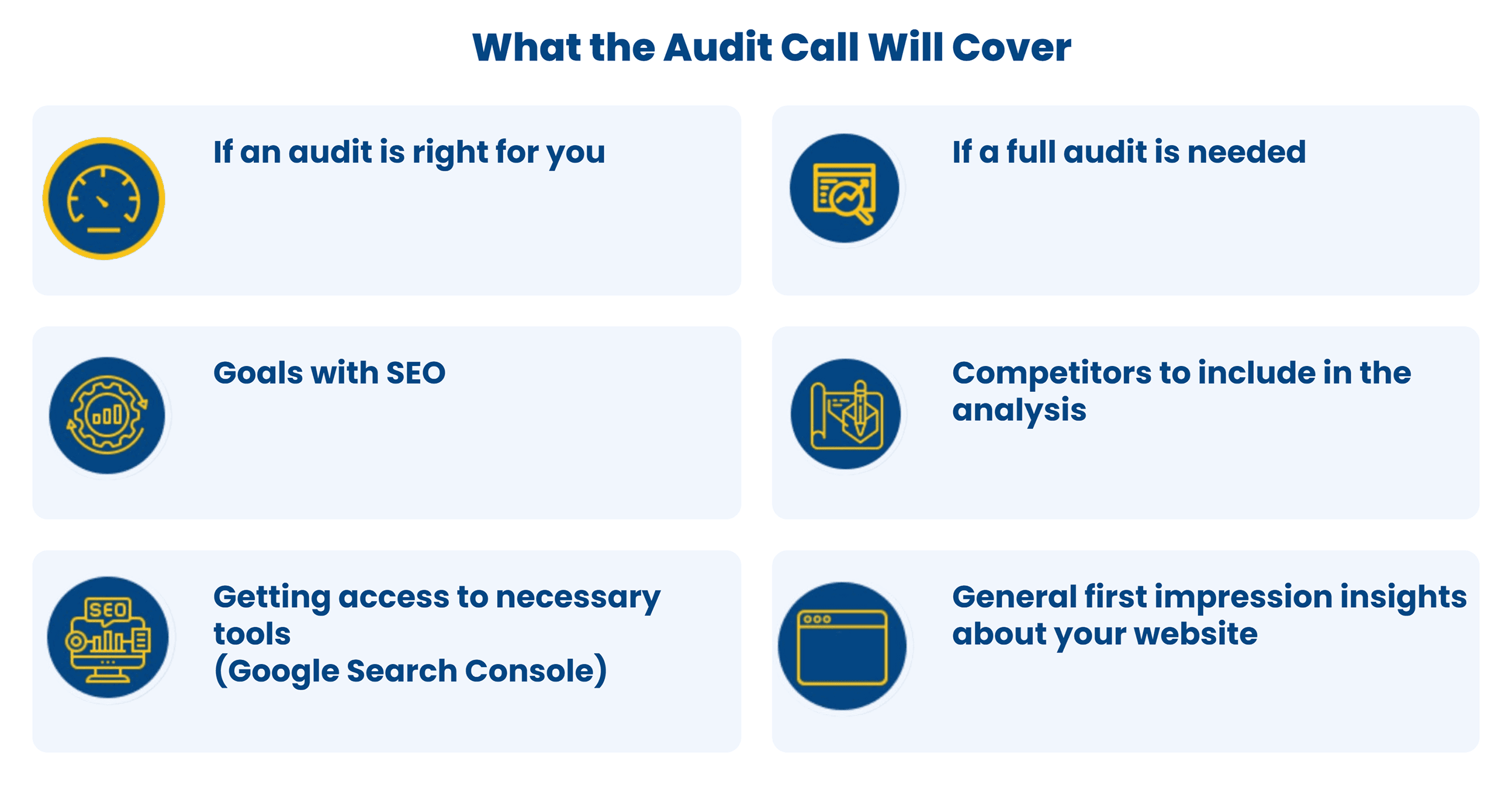
Once prospects see the issues affecting their site, they’re way more motivated to get started with services.
But this isn’t a selling technique.
If clients see the audit as a pitch, then you’re just another company pitching them.
When you position your audit as a roadmap, it’s much easier to present a legitimate vision for the client.
Ben Goodey, founder of the SEO growth agency Spicy Margarita, agrees that leading with value is essential.
My top advice for those looking to sell SEO? Know your audience doesn’t want to buy SEO. They’re business owners or team leaders who want to buy results—that is what you should focus on selling.
In my experience closing clients, the more freely you share your “how,” the more trust and enthusiasm you build with a client. So, share your tactics openly—people are typically willing to take a risk working with you if you’re an expert.
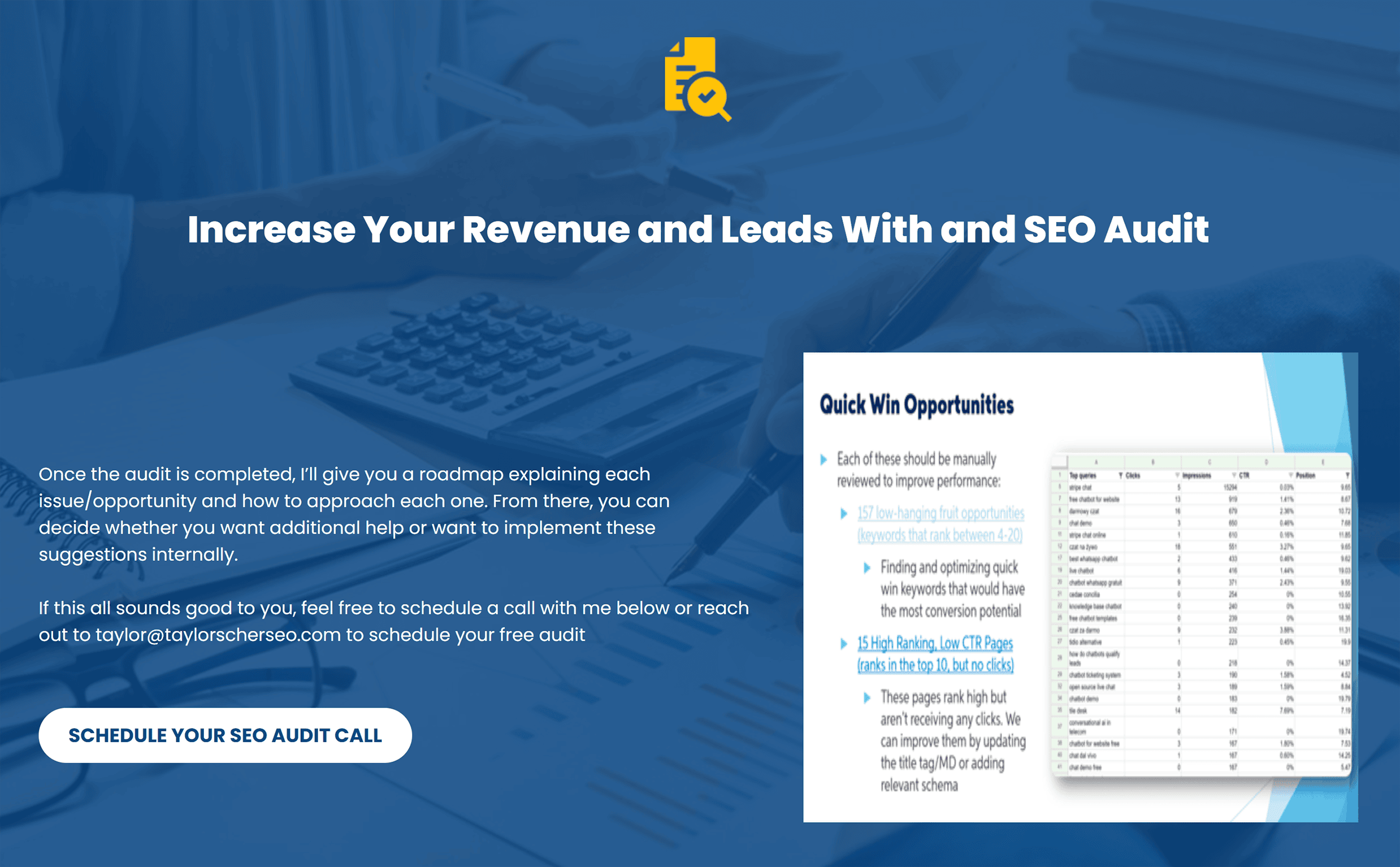
The idea is that the audit should be so helpful prospects can take the information and use it on their own.
“But why would you do that?”
Sure, it sounds like it wouldn’t make sense. But think about most companies that lack internal marketing teams.
Most of the time, they don’t want to handle marketing and SEO themselves.
They would rather outsource it to another team.
So, even though they COULD take the audit and run, chances are they’d rather have someone else manage it anyway.
Plus, if they do decide to move forward, it shows their level of trust in what you’re proposing.
Which is a great sign for longer-term engagements.
If you didn’t schedule the audit at the end of your strategy call, use this template to follow up by email:
Subject: Next Steps – [Company Name] SEO Strategy
Hi [Name],
Thank you for taking the time to discuss [Company Name]‘s SEO goals today. I wanted to follow up with a quick summary of what we covered and outline our next steps.
- Your main goal: [specific goal mentioned in call]
- Current challenges: [1-2 key challenges mentioned]
- Priority areas: [2-3 areas of focus]
During our call, I noticed [specific quick win mentioned during call]. You can implement this immediately by [brief actionable step].
Next, I’ll prepare a comprehensive SEO audit for your site. Are you available to review the findings on [scheduled date/time]?
In the meantime, please do not hesitate to reach out if you have any questions.
Best,
[Your name]
Build a Reliable Stack for Conducting Your Audits
I keep my tech stack pretty consistent for most audits.
The ones I find helpful and recommend using are:
- Google Search Console: Find crawling/indexing issues, quick SEO wins, and potential content topics
- Screaming Frog: Uncover large-scale technical issues like missing canonicals or JavaScript issues
- Google Analytics 4: Extremely useful if a client has set up conversion tracking. See what pages have previously driven conversions and how you can double down on that.
- Semrush site auditing features: Identify housekeeping items to take care of, such as orphan pages, broken links, and redirect chains
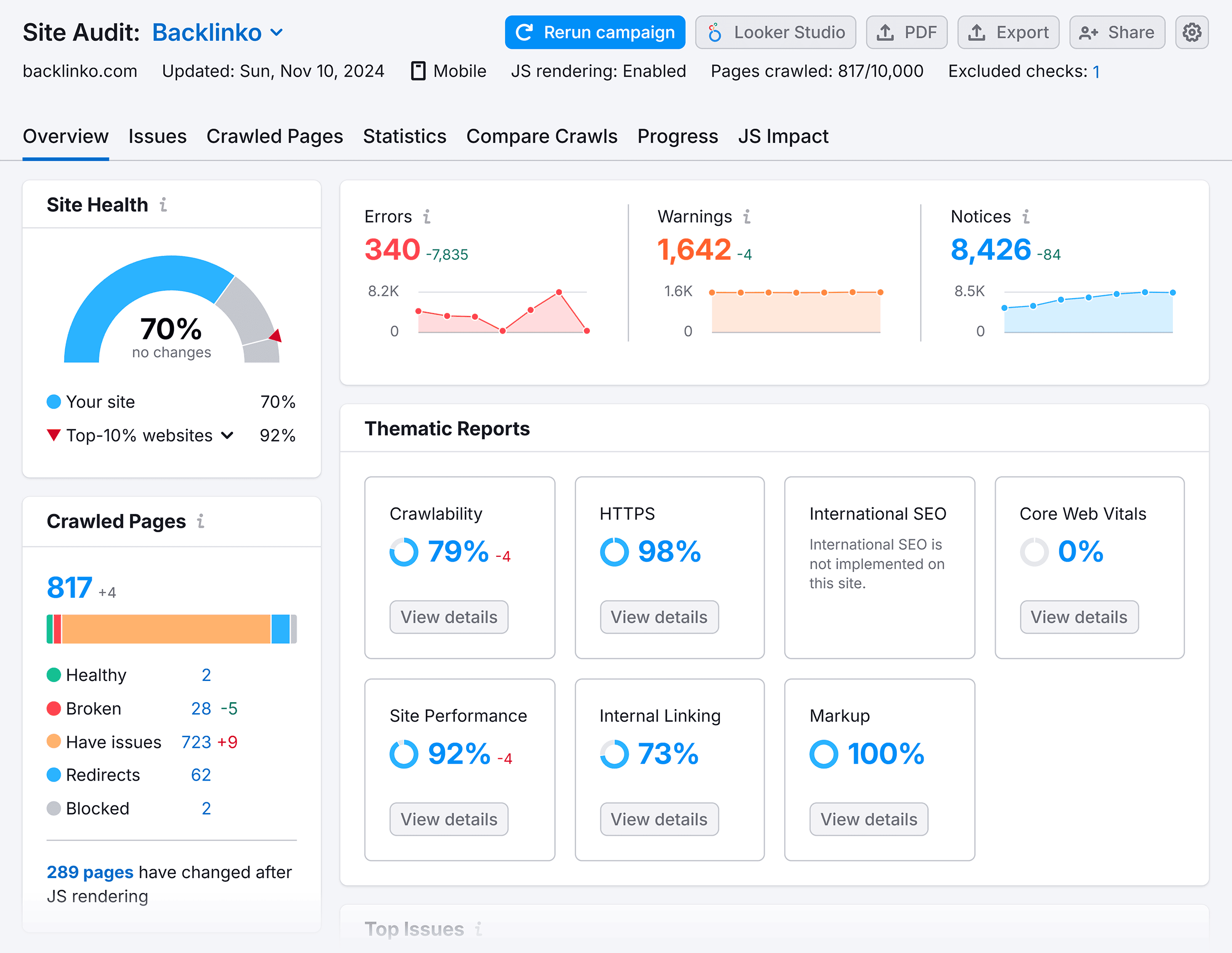
Focus on Value, Value, Value
When you’re delivering the audit, focus on value.
And I don’t mean to just stuff it with data and overwhelm the client.
Remember: This is also for you, not just the client.
I find it helpful to start with an overall strategy, like how I’ll increase revenue by X% through SEO.

Then, I recommend SEO tactics that will help the client achieve the goal.
But this isn’t the time to be vague—I show exactly how I’ll hit that number.
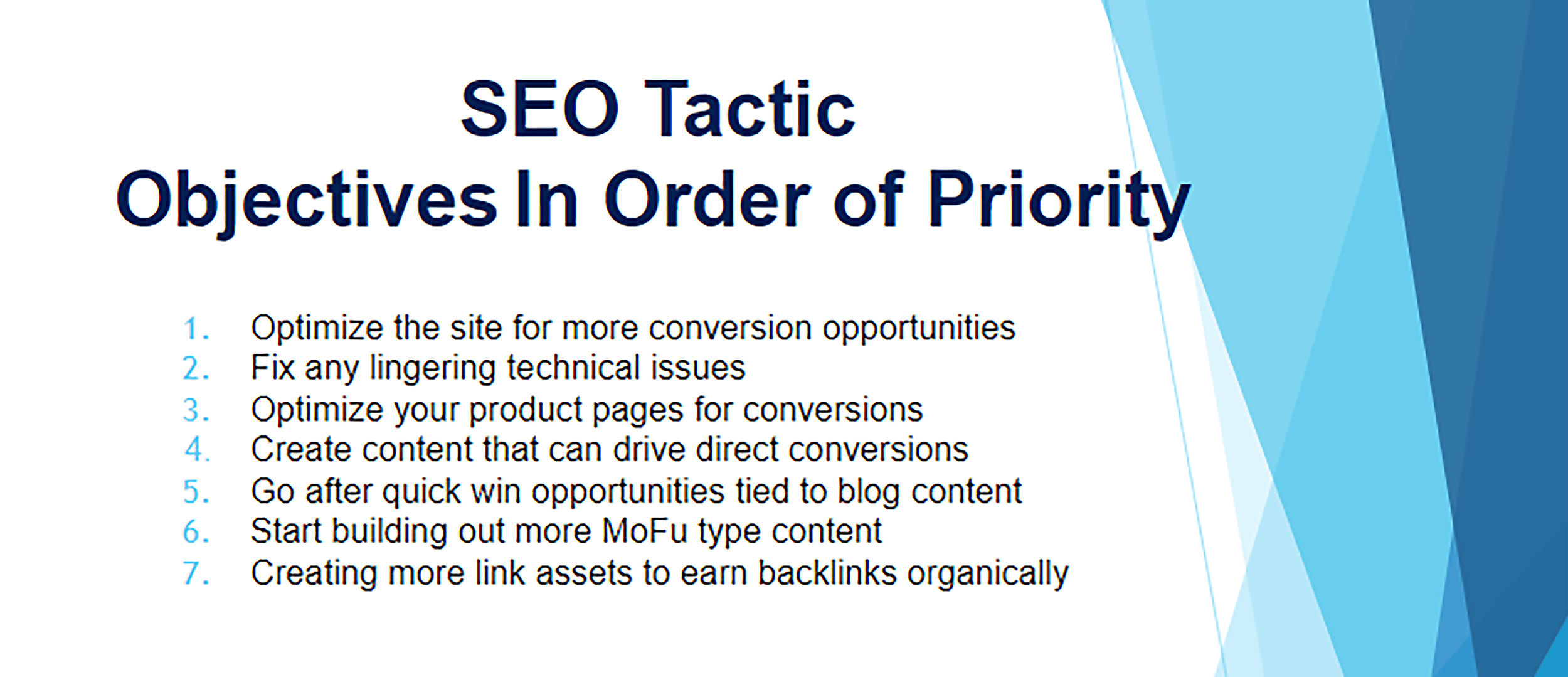
When you start with a goal, the client has an easier time understanding what you’re recommending and why.
So, let’s say the goal for a B2B SaaS company is to increase demos and freemium signups through SEO.
You’d focus your audit on:
- Low-hanging fruit keywords tied to their money pages
- Ways they can improve their site from a conversion rate optimization standpoint
- Non-indexed pages that aren’t driving traffic
- A full competitor audit
- A content roadmap based on topics that would drive leads
Side note: There will be times when clients still choose not to work with you despite all your work—and that’s okay. As long as your overall close rate increases, that’s all that matters.
5. Send a Proposal or SOW
Now comes the easiest part.
Sending out the SEO proposal or statement of work (SOW).
If you ran your audit properly and the client showed interest in what you had to say, the proposal should be a piece of cake.
Still, there are a few things to keep in mind during this step of the process.
Include Audit Findings
For the beginning of the proposal, include findings from the audit.
It doesn’t have to be anything fancy.
I usually use:
- Google Docs for the template
- Canva for custom graphics
- Data screenshots if I have access to GA4 and GSC
- Google Sheets if forecasting is involved
You’ll want to touch on the recommended priority tactics and how you’ll approach them.
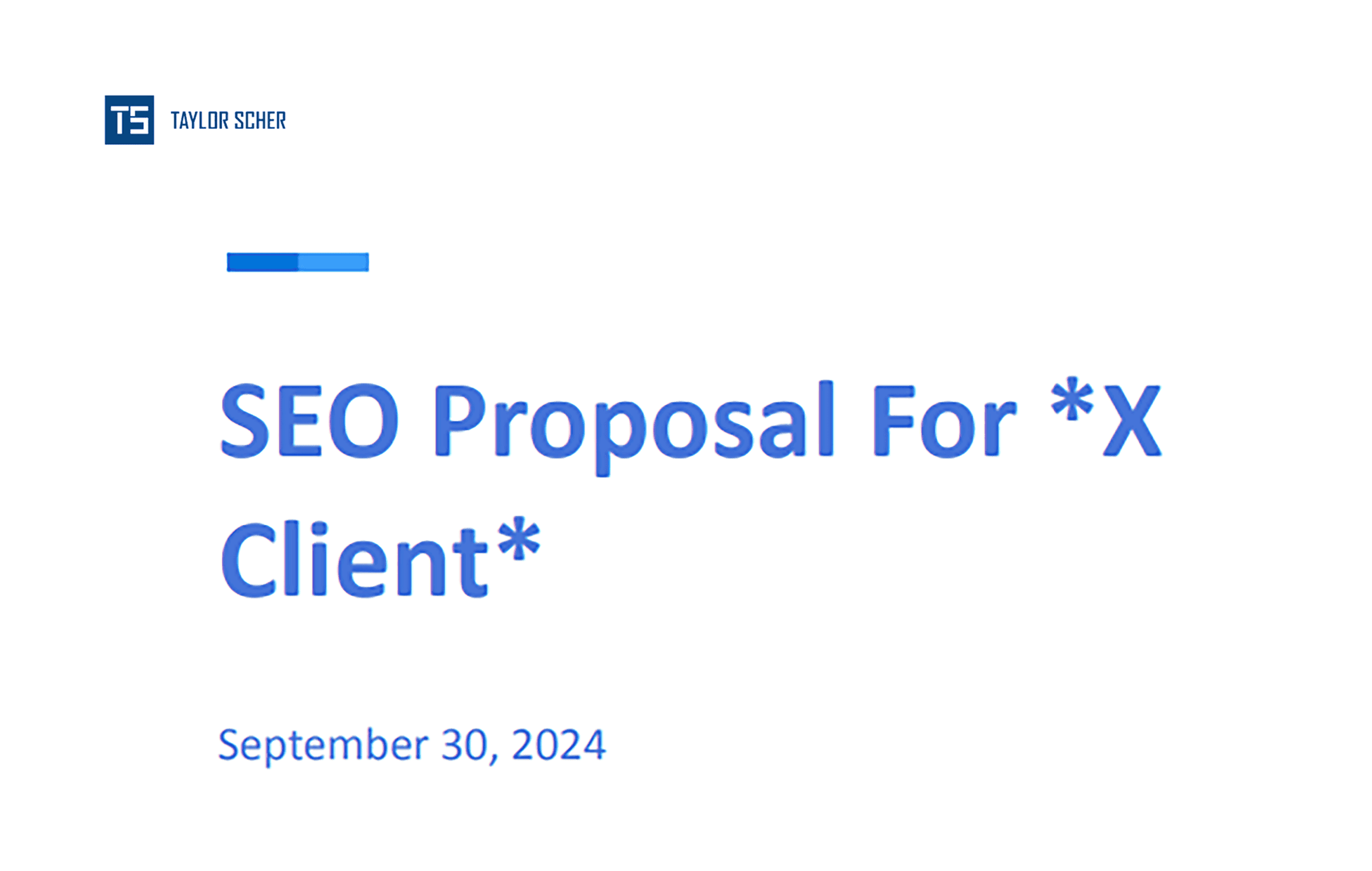
You can also include a monthly timetable to visualize how you would structure each month of the engagement.
For me, it usually looks like this:
- Month 1: Start with conversion rate optimization, technical SEO, optimizing your product pages, going after quick wins, and taking care of any on-page housekeeping
- Month 2: Continue going after quick wins, start building out BoFu content
- Month 3: Continue creating BoFu content, creating link assets, and backlink opportunities
- Month 4-6: Build out a solid profile of MoFu content, continue going after quick wins
Help your clients understand how you’ll approach each month for the engagement.
This way, they’ll have a better reference point for understanding what you’ll be working on.
The success behind selling SEO comes from value, trust, and transparency.
Don’t neglect any of them.
Highlight Your Goals/Strategy/KPIs
This will be similar to what you did for the audit but in more detail.
First, lay them out as a goals section.
Then, explain specifically how you’re going to work towards those goals.
Here’s an example of what this looks like on my proposals:
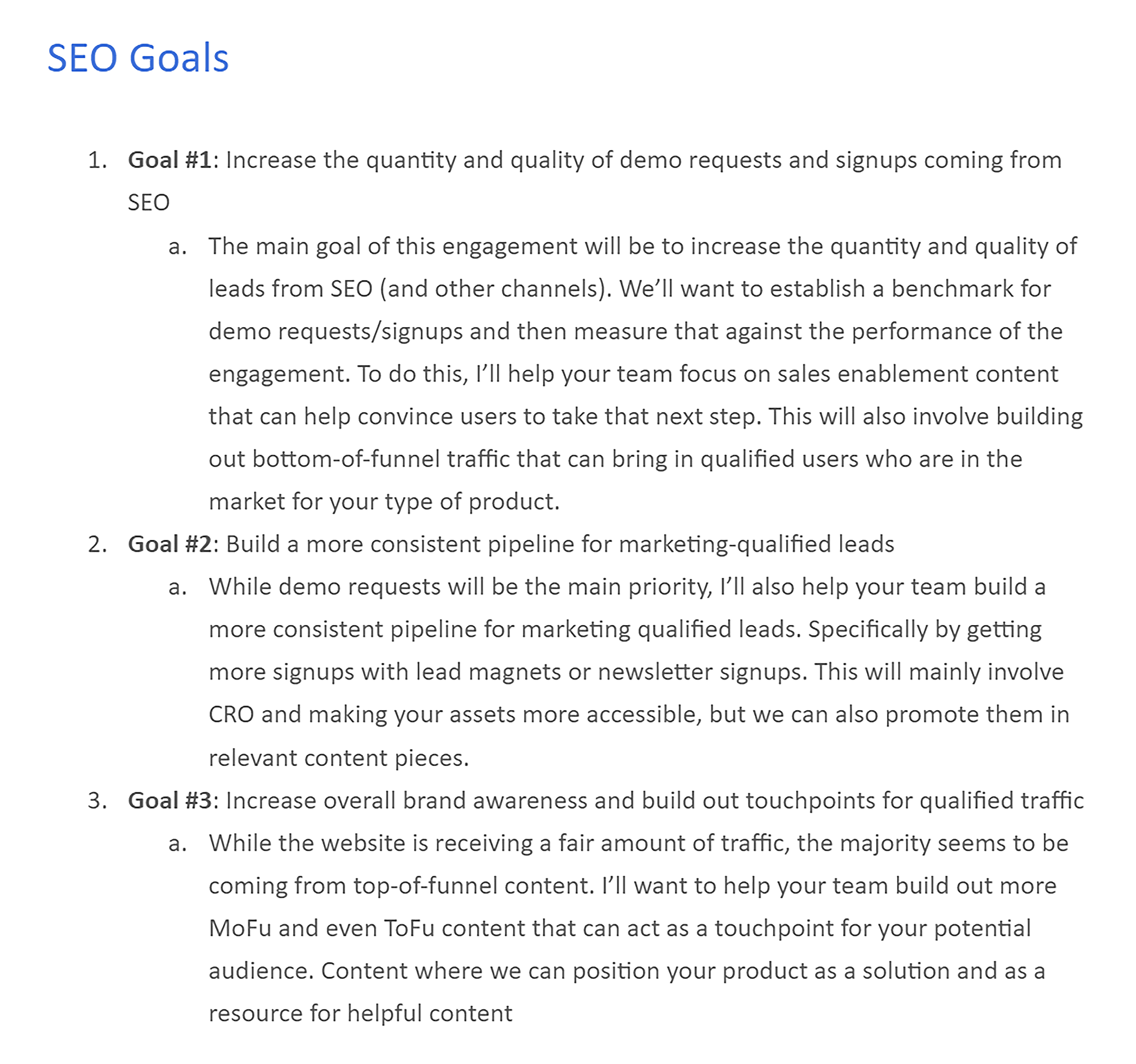
Now, let’s break this process down.
First, I summarize each goal:
“Goal #1: Increase the quantity and quality of demo requests and signups coming from SEO.”
Then, I add more detail to show I understand what success looks like:
“The main goal of this engagement will be to increase the quantity and quality of leads from SEO (and other channels). We’ll want to establish a benchmark for demo requests/signups and then measure that against the performance of the engagement.”
Finally, I outline my action plan:
“To do this, I’ll help your team focus on sales enablement content that can help convince users to take that next step. This will also involve building out bottom-of-funnel traffic that can bring in qualified users who are in the market for your type of product.”
I also include a section that discusses the main opportunity behind the project.
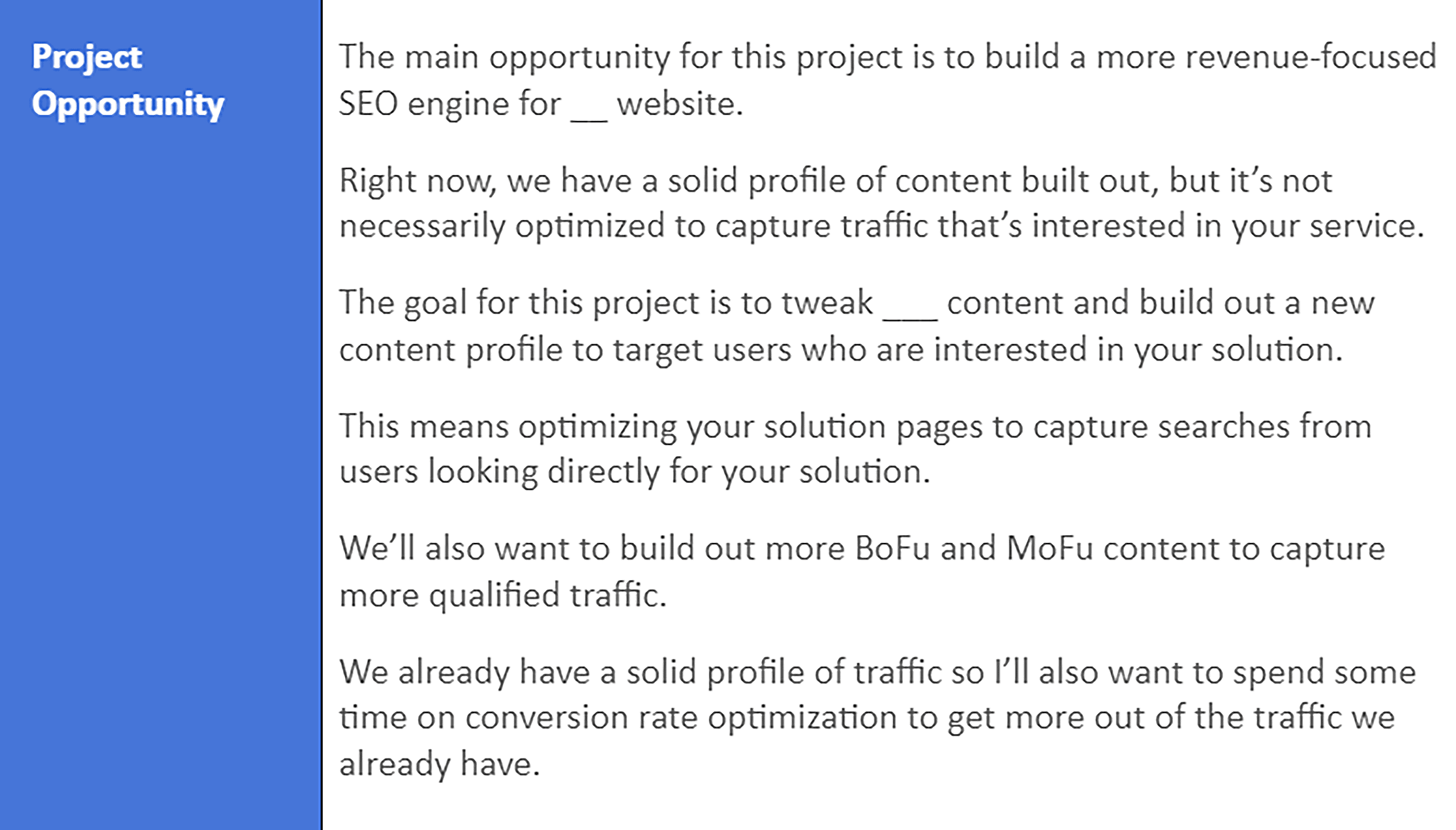
What’s the ultimate value that’s going to come out of this engagement?
I’ll often structure it similarly to the goals listed above.
But it’s usually a more general overview of the project as a whole.
You can also have a section on KPIs.
I generally save specific KPIs for the actual onboarding meeting (once they’ve signed the proposal), but I’ll usually have a section in the proposal that looks like this:

So, there are no specific percentages tied to those KPIs, just what we’ll be prioritizing.
Detail Contract Terms (Make Them Fair to the Prospect)
Ahh, the contract terms.
The fun part.
I highly recommend working with a lawyer on this one.
Your contract terms will be pretty consistent across most proposals, but they should be fair to you and the prospect.
The lawyer can help you put terms in place that safeguard you and your business during any engagement.
As for the actual general terms, I recommend including:
- The hard start date so both parties can prepare appropriately
- The length of the engagement so clients know how much to budget for
- The pricing terms and dates
- If the contract is rolling, month to month, or a fixed date project
- The flexibility of the contract, meaning if clients are locked in or able to cancel at any time

Once you have that set, all you need now is a signature.
Then, you’re basically ready to get started with your client.
Bonus Tips to Keep in Mind When Selling SEO Services
Are you tired of hearing me talk yet?
I hope not.
I have some bonus tips that will help you refine your selling approach and close more leads.
Master the Follow-Up
My personal motto is simple:
Keep following up until you get a response.
Why?
Most leads won’t respond on the first try. Or the second. Or even the third.
So, reach out to prospects once a week to see where they are in the process.
This is where your CRM becomes your best friend.
It helps you:
- Track when you last reached out
- Set follow-up reminders
- Note any previous interactions
- Monitor prospect engagement

But here’s the catch:
This aggressive follow-up strategy works best with warm prospects.
Cold prospects? Not so much.
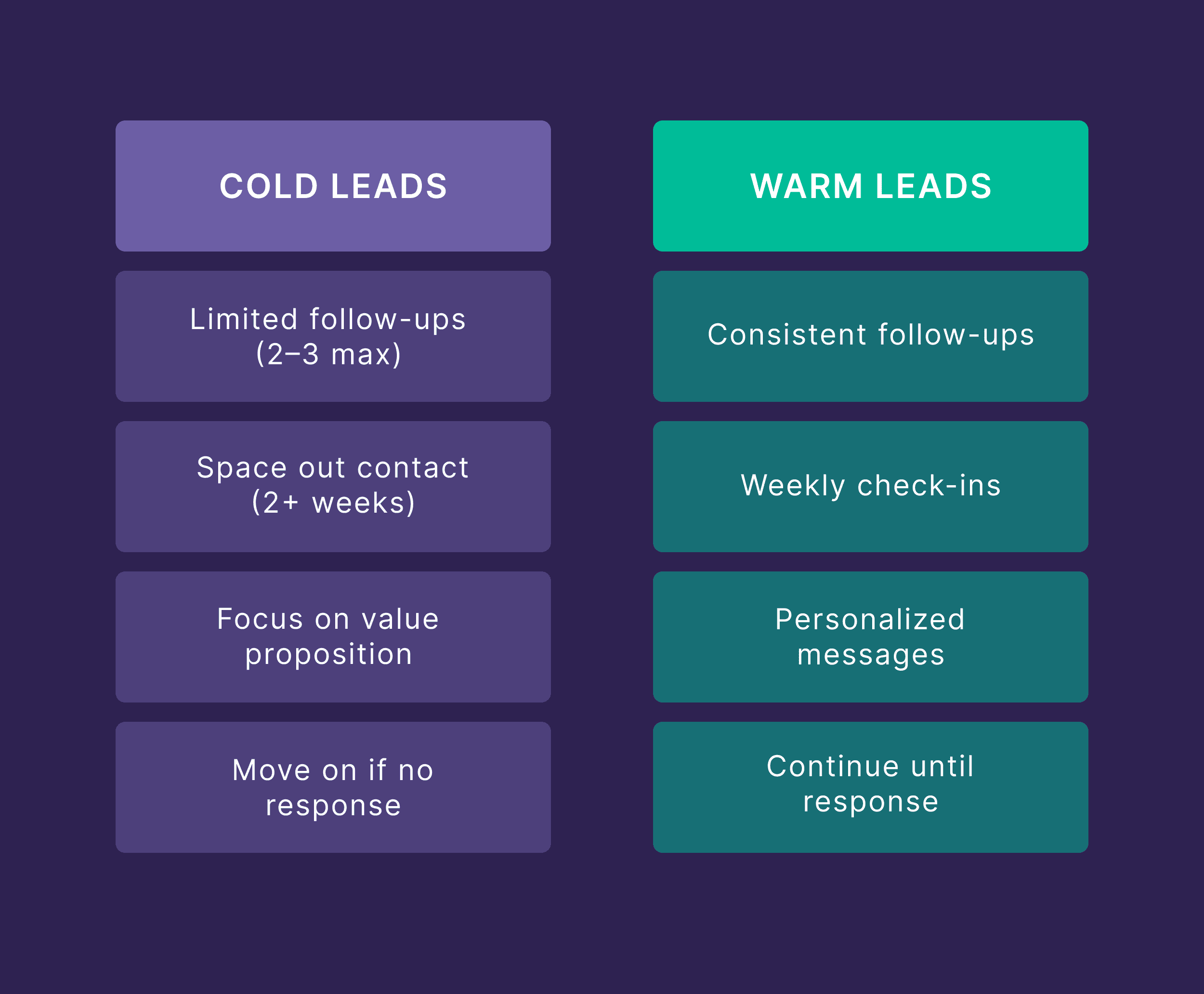
I won’t tell you to annoy your prospects.
But don’t be shy, either.
Use Traditional Sales Psychology
I can’t believe I’m saying this, but I’m extremely grateful for that Sales 101 class I took in college.
I might’ve treated it as a joke in college, but that class has helped me drive thousands in monthly recurring revenue (MRR) just by using traditional sales techniques.
Don’t get me wrong, I’m not a schmoozer by any means whatsoever.
But psychologist Robert Cialdini’s principles of persuasion work extremely well throughout this entire process:
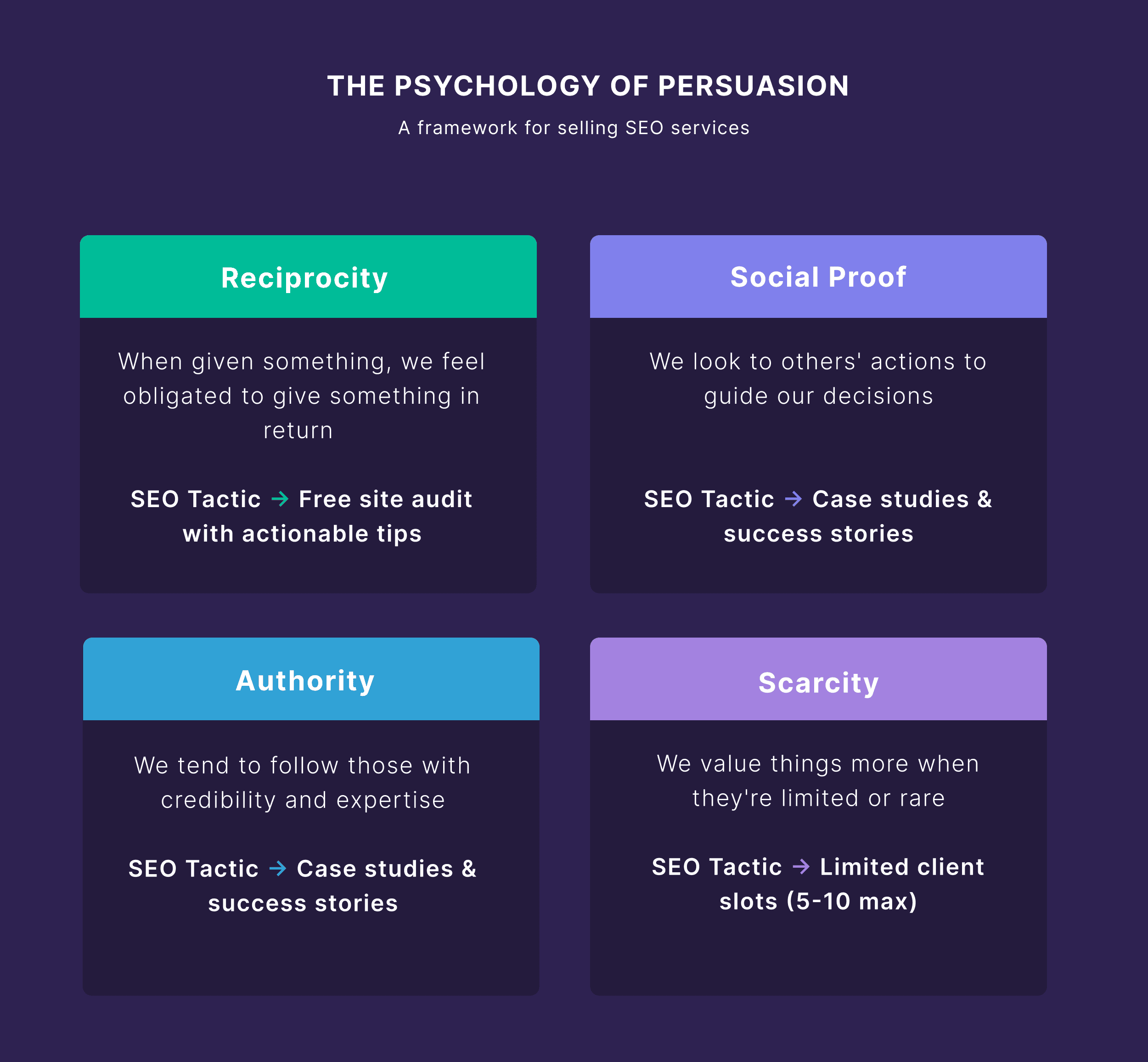
Reciprocity
People feel compelled to return favors, which is why free audits work so well.
When someone gives us something, we instinctively want to reciprocate.
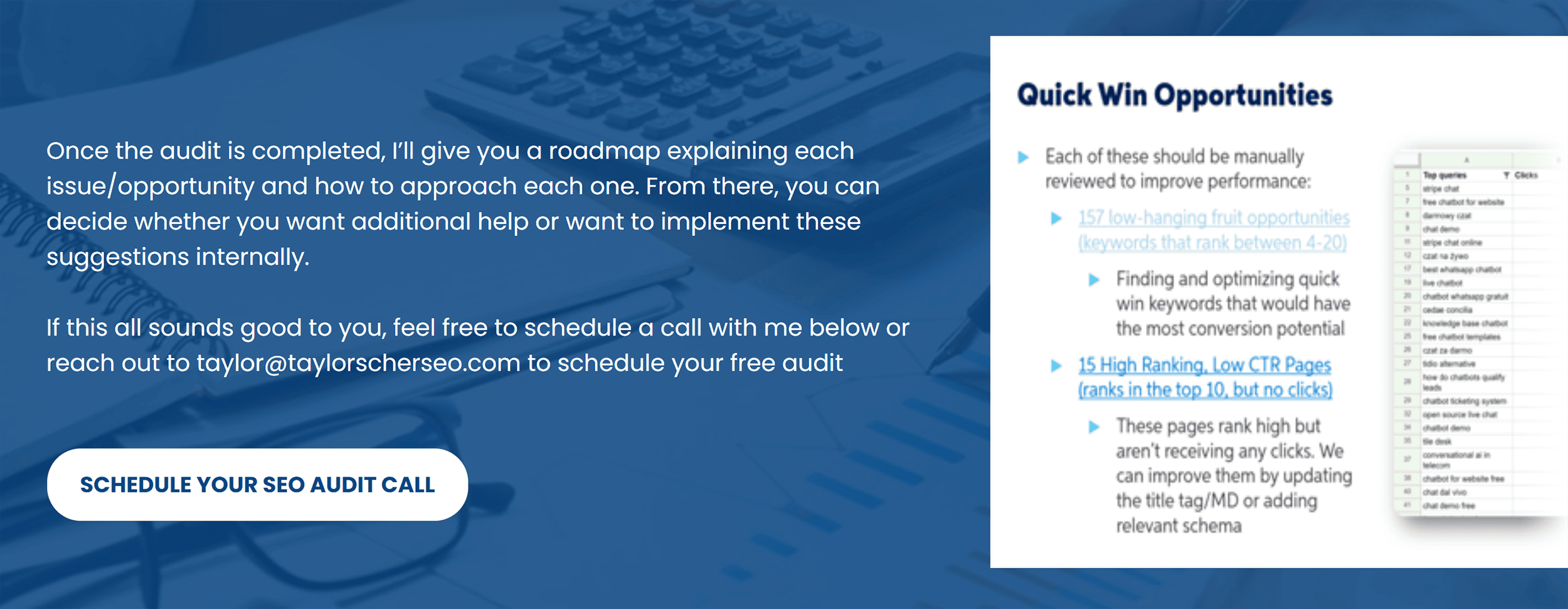
Not in a manipulative way but as a natural response to receiving something valuable.
This subtle tactic can help you turn prospects into clients.
Social Proof
Your reputation is one of your greatest sales tools.
People want reassurance that they’re making the right choice—especially for something as important as SEO.
You can pitch yourself all you want, but if you don’t have any proof of results, why should they believe you?
The more people who vouch for you, the more people will trust you.
This could be:
- Case studies
- Brands you’ve worked with
- Testimonials
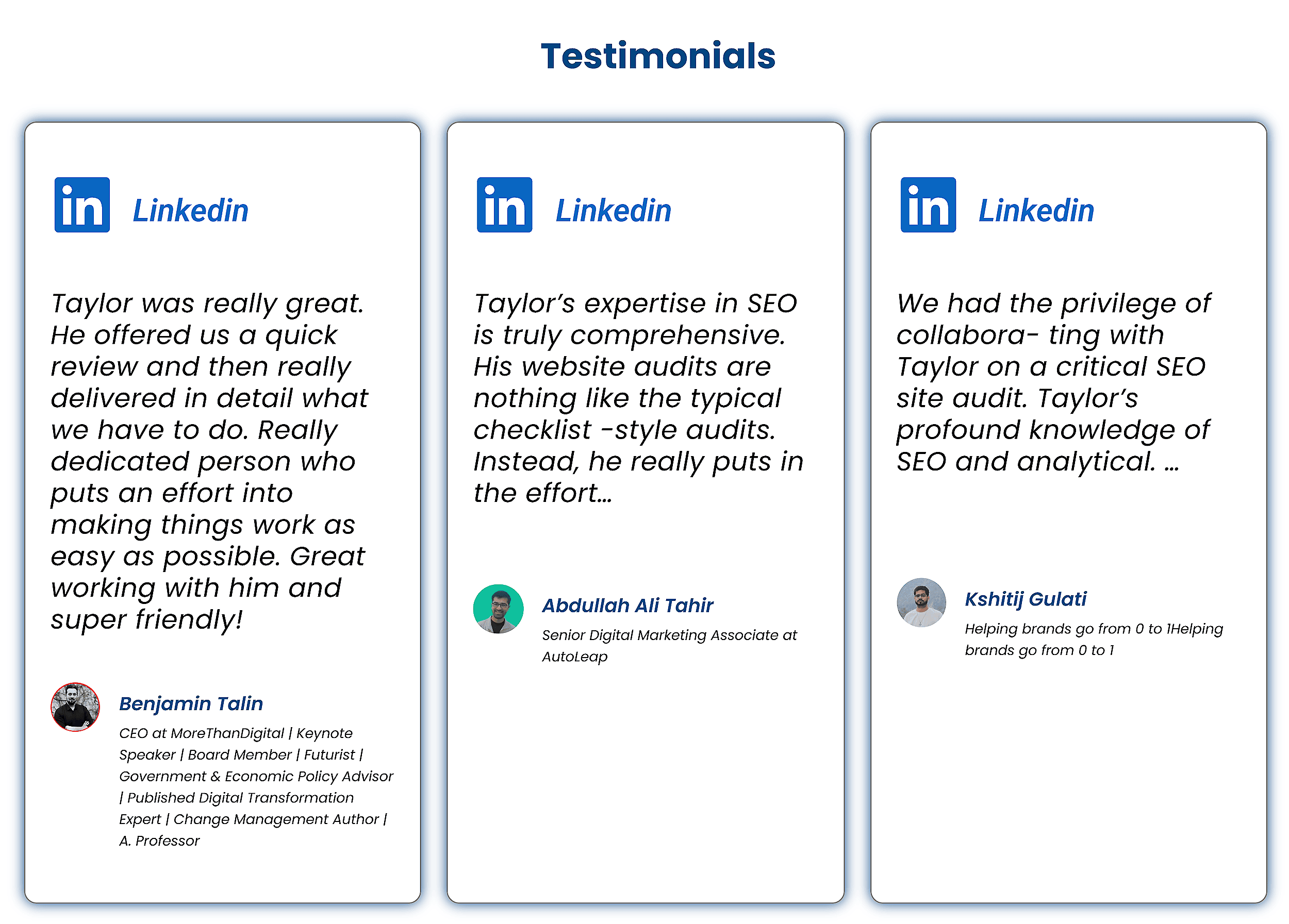
Whatever it is, let your existing/previous clients be your most vocal supporters.
Authority
Establishing authority is huge for building trust.
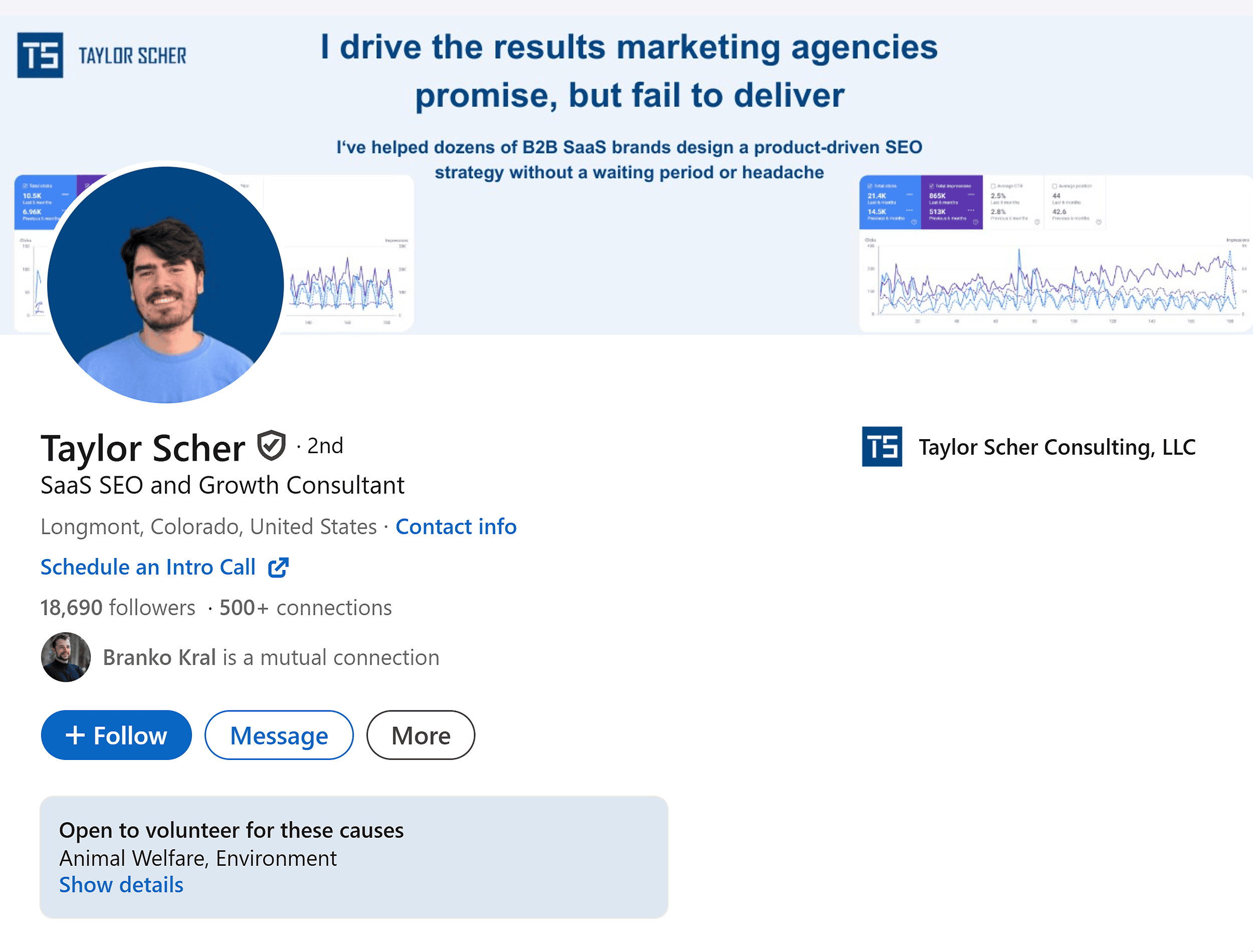
When people see you as an authority in your field, they’re more likely to trust what you have to say.
You can:
- Post content specific to your ICP on LinkedIn
- Write for highly authoritative websites
- Collab with well-known industry leaders
- Be a guest on or host webinars or podcasts
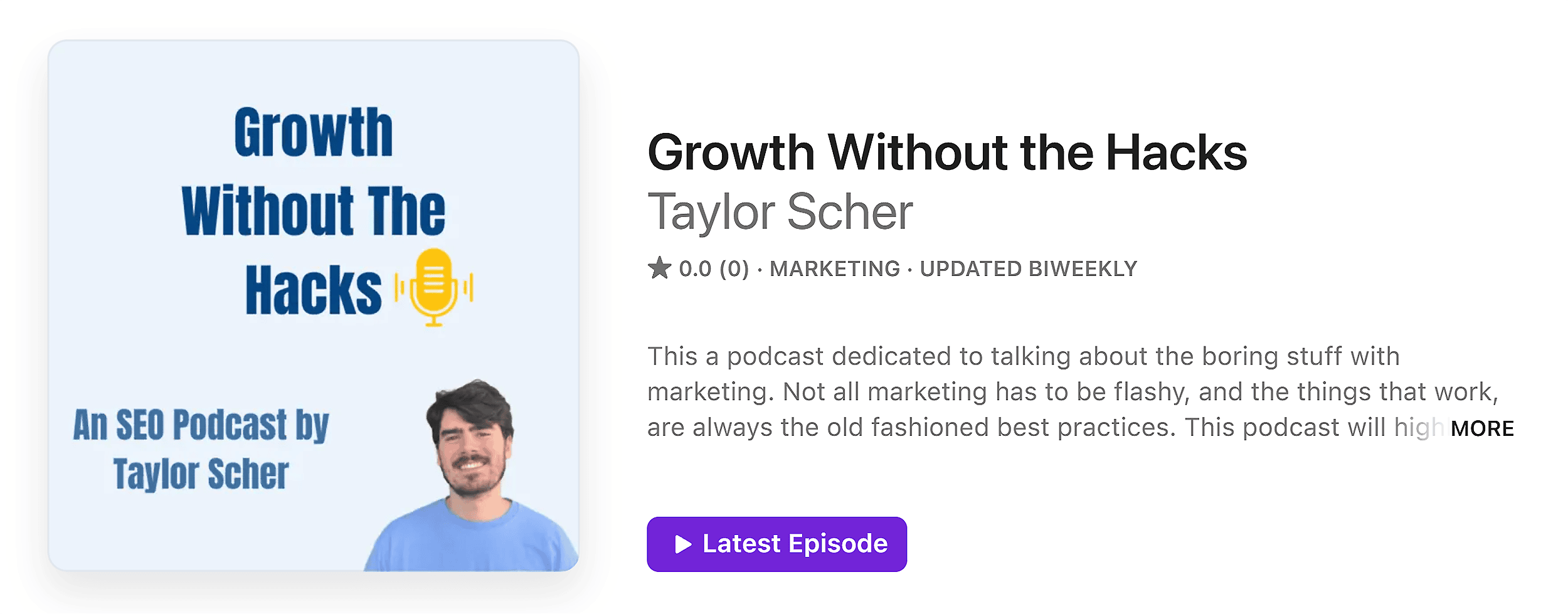
This establishes your expertise and authority in your field.
With that positioning, people already have a sense of trust in me before we even meet on a call.
It also makes prospects more excited to work with me.
My professional reputation adds a perceived value to my services.
As a result, prospects aren’t as likely to question my prices since they know the value my work delivers.
People don’t want to work with the smooth-talking ‘SEO expert’ who promises the world but doesn’t deliver.
They want a partner or team member they can relate to and trust.
Someone who’s passionate about what they do, genuinely invested in helping them, and overall seems like a fun person to work with.
That’s why I’ve been so focused on demonstrating value over selling.
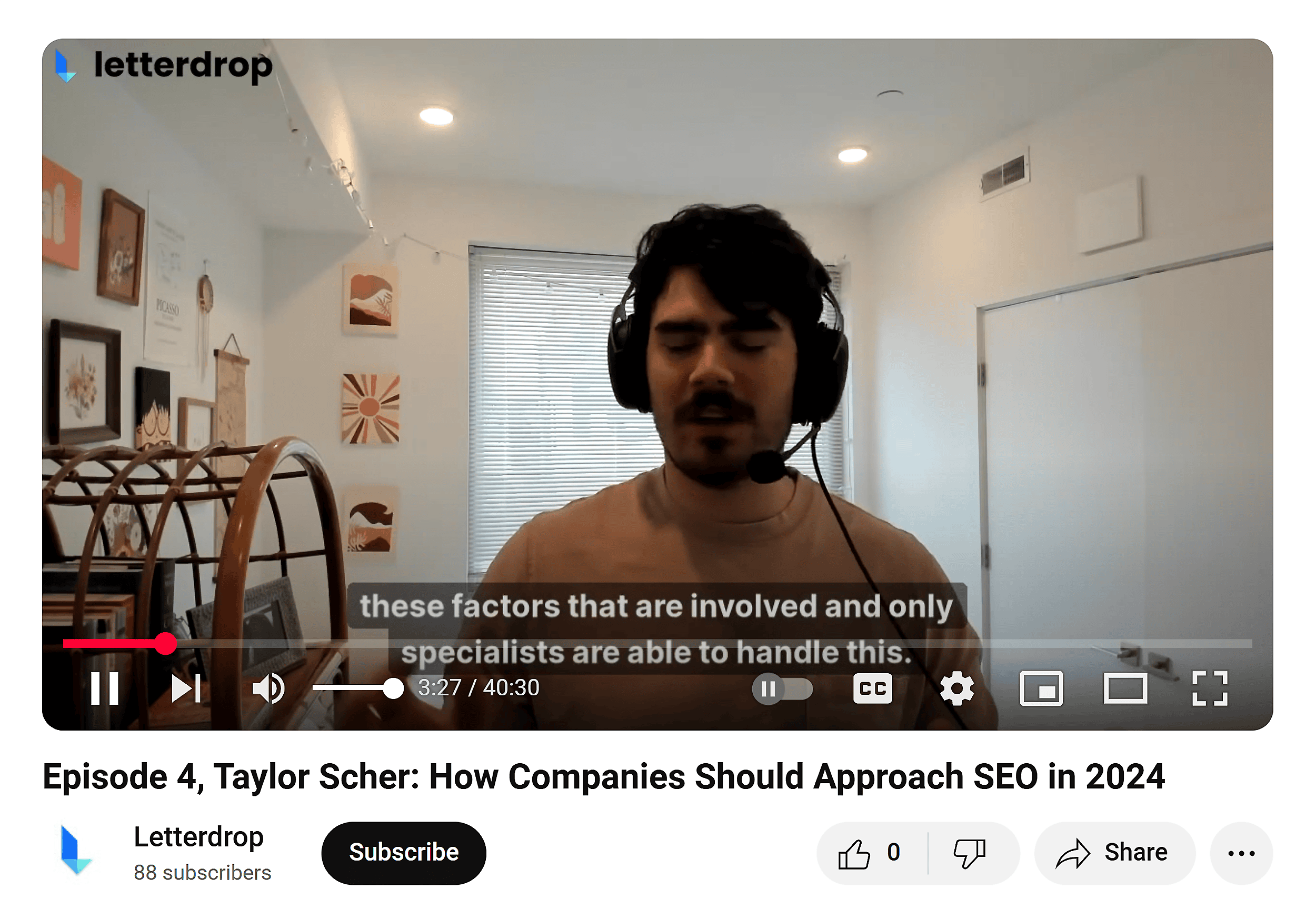
Focus on being seen as a partner, not just another vendor.
Further reading: Guest Blogging: The Definitive Guide
Scarcity
Scarcity works surprisingly well.
People get FOMO.
It’s a common human experience.
As a solo consultant, I’m not interested in scaling to take on unlimited client profiles.
I want a small batch of handpicked SEO clients who are invested in working with me.
Usually, this comes out to five to 10 monthly clients based on the scope of services.
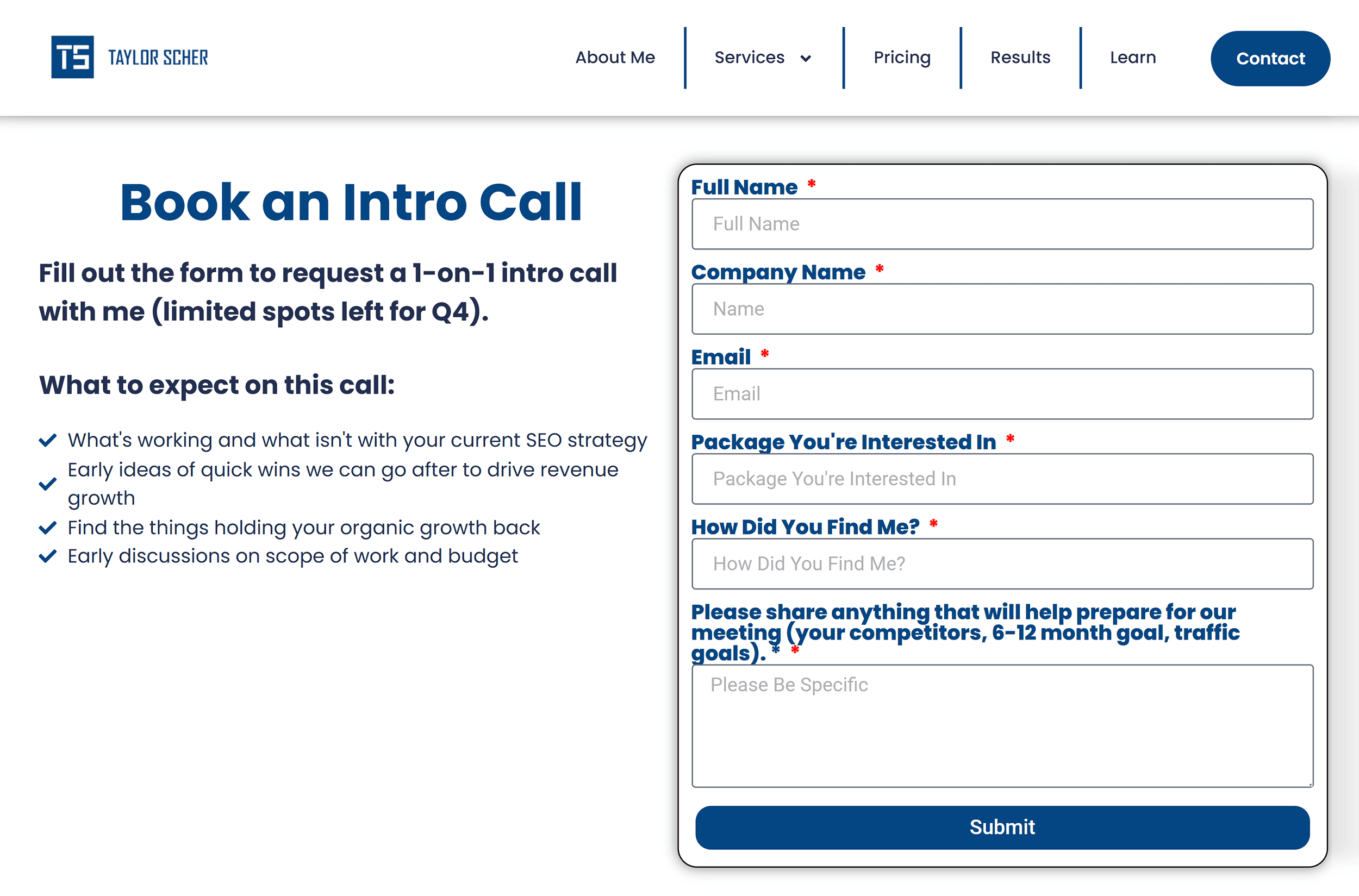
If I stretch myself too thin, I can’t give every client the attention they deserve.
So, if I have multiple prospects who are interested in that last position, my availability becomes scarce.
And as my scarcity increases, pricing can follow.
That’s not to say you should have leads fight over that last spot.
But it is something to mention to your prospects, as it can make you seem like a more desirable candidate.
Keep Leads Interested
While each hard-set date will help keep prospects interested, they can still get distracted.
Other agencies may poach them, they can get pulled in new directions, or their schedule may become too tight.
Even the slightest hesitation can derail your efforts.
So, beyond moving them throughout the sales process, you can keep them interested in a few ways.
Post Client Wins on LinkedIn
Case studies work.
We know this.
But it’s another thing to put it out there for everyone to see–especially when you can use it as an opportunity to explain that case study in detail.
It also makes you way more desirable, so it might even trigger FOMO for them if they feel like others might reach out to you because of that case study.
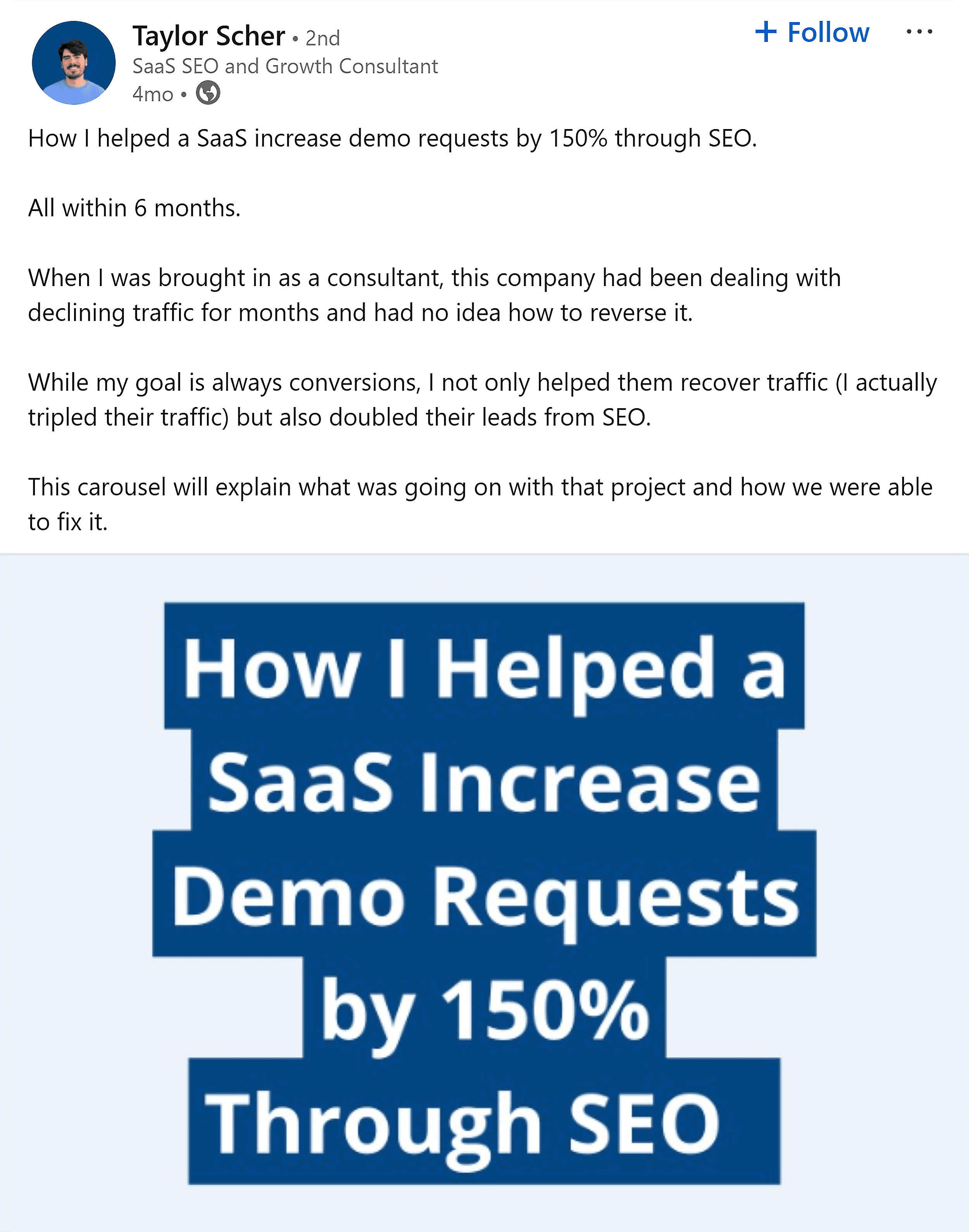
Even from one case study post, I had three to four qualified leads reach out.
Provide a Reference from a Previous Client
This shows a huge amount of transparency that is surprisingly rare.
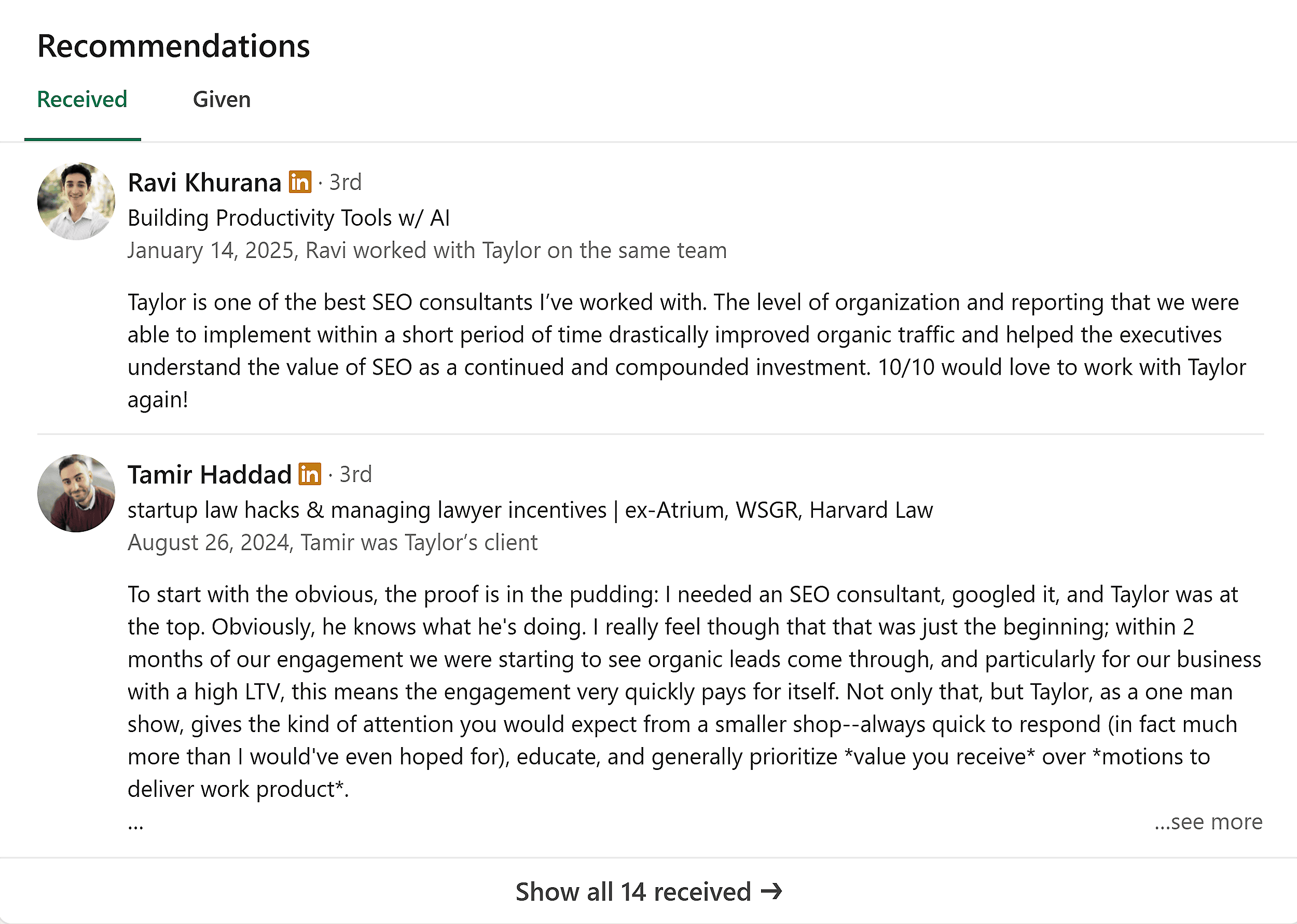
Even before they ask, offer them a client referral from a similar industry.
Focus on the Relationship, Not the Sale
People buy from individuals they trust, not just from salespeople.
Especially in the early stages, when a prospect can easily move on to another offering, you can keep yourself memorable by focusing on developing a relationship.
Be likable.
Be funny.
Be authentic.
Be personal.
Go beyond just being seen as an SEO provider.
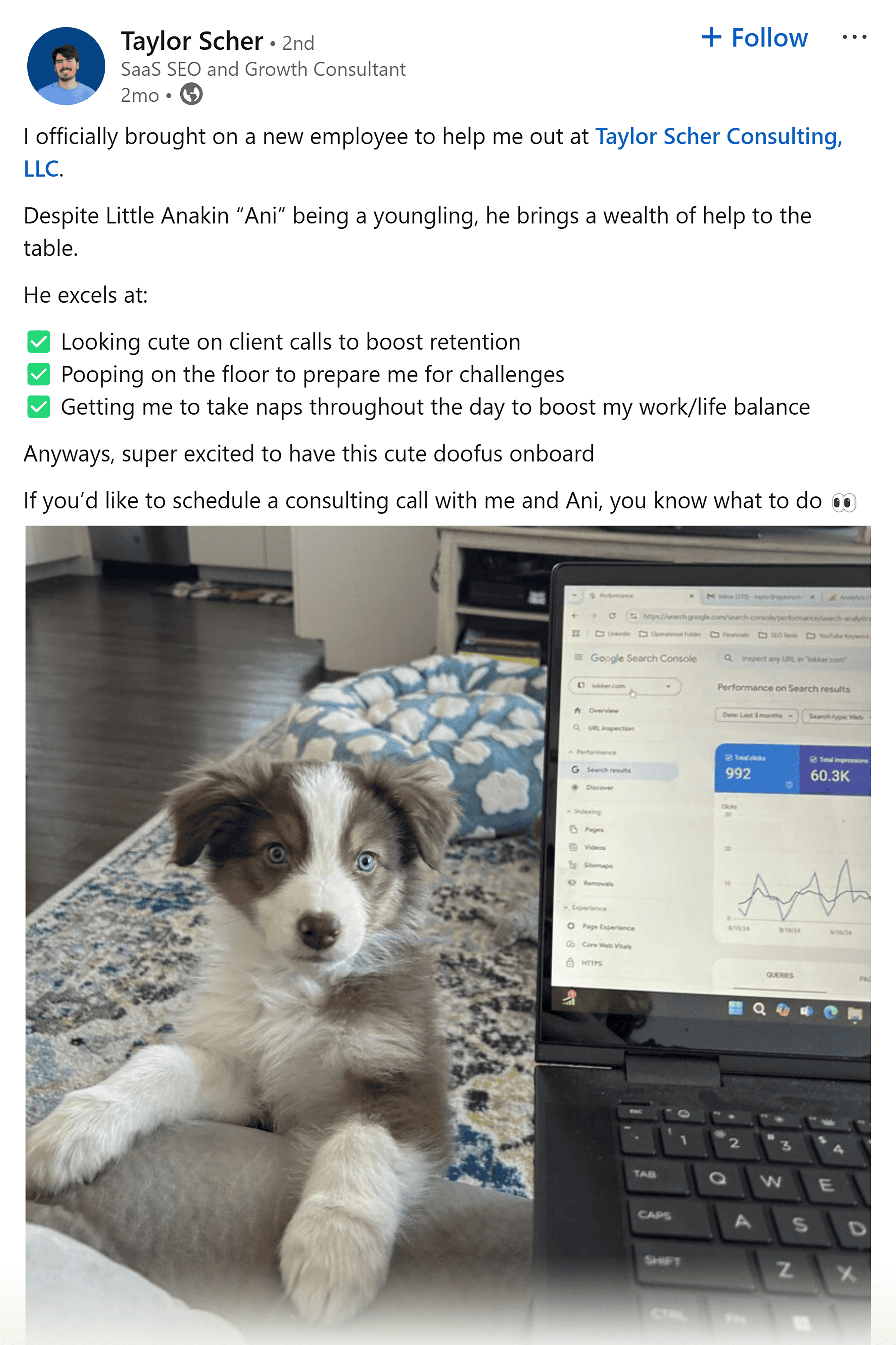
Treat every prospect as an opportunity to develop valuable relationships, not generate sales.
And even if the lead falls through, that relationship still has value.
It can lead to future opportunities like a referral or a personal connection request.
Even if that lead doesn’t work out, it’s still an opportunity to expand your network for future opportunities.
Sell SEO Services Like a Pro
Selling in SEO is just a matter of delivering early value to your prospect.
I’m not even a salesperson.
I’m just an SEO who had to force myself to learn sales.
And honestly, if I can do it, you can do it, too.
Learn how to translate the value of your work into a language your prospects understand.
Now that you know how to sell SEO services, you can start landing clients more consistently.
But first, make sure you have the right tools to deliver the results your clients deserve.
Check out our article on the best SEO agency tools on the market.
Including some free options you can use today.
The post How to Sell SEO Services in 5 Steps<br>+ Expert Tips & Templates appeared first on Backlinko.
این خبر را در ایران وب سازان مرجع وب و فناوری دنبال کنیدجهت دانلود و یا توضیحات بیشتر اینجا را کلیک نمایید





